
 |
| Book 2 |
Canal Cruising 1983 to 1999
An eBook by Cyril J Wood
|
|
|
|

|
The title photograph shows Beeston Iron Lock on a |
|
sunny, summer's day in 1982 looking from Bridge 107 |
Click on title to follow links
|
|
|
Book 2 |
Canal Cruising 1983 to 1999 is a true story
Chapter 1 - “Misty Waters”
As mentioned in “Canalscape 1”… Chapter 7 – Beeston Days... in 1982 I was exploring the possibility of buying an inexpensive boat myself. When going to the various boatyards to purchase bits for “Phial” I would always look to see if they had any reasonably priced boats for sale. At Venetian Marine of Cholmondeston they had brand a new beige “Dawncraft” 22 complete with Honda 100 outboard motor on display outside the saleroom on the car park. I remember looking over it and admiring the exterior finish and the way that the interior was tastefully trimmed (orange dominated – fashionable at the time and it matched the beige of the exterior). It would have been nice to have been able to afford a brand-new boat but my budget would not have stretched to that. So it was back to looking around the boatyards. We didn’t go out of our way boat-hunting but an opportunity was about to unexpectedly present itself.
On Thursday 18th August 1983, whilst visiting Mother and “Phial”, we saw Ken Docherty, the man that lived at “Stone Lock Cottage”, Beeston, towing a fiberglass cruiser on a trailer to his house. We were quite friendly with Ken and his wife, Caroline. She baked the most beautiful pies and preserves and sold them to boats going through the lock. When we were purchasing one of these pies a couple of days later, I enquired about the boat. Knowing of my interest in boats, Ken told me that it was for sale and invited me around to have a look at it.
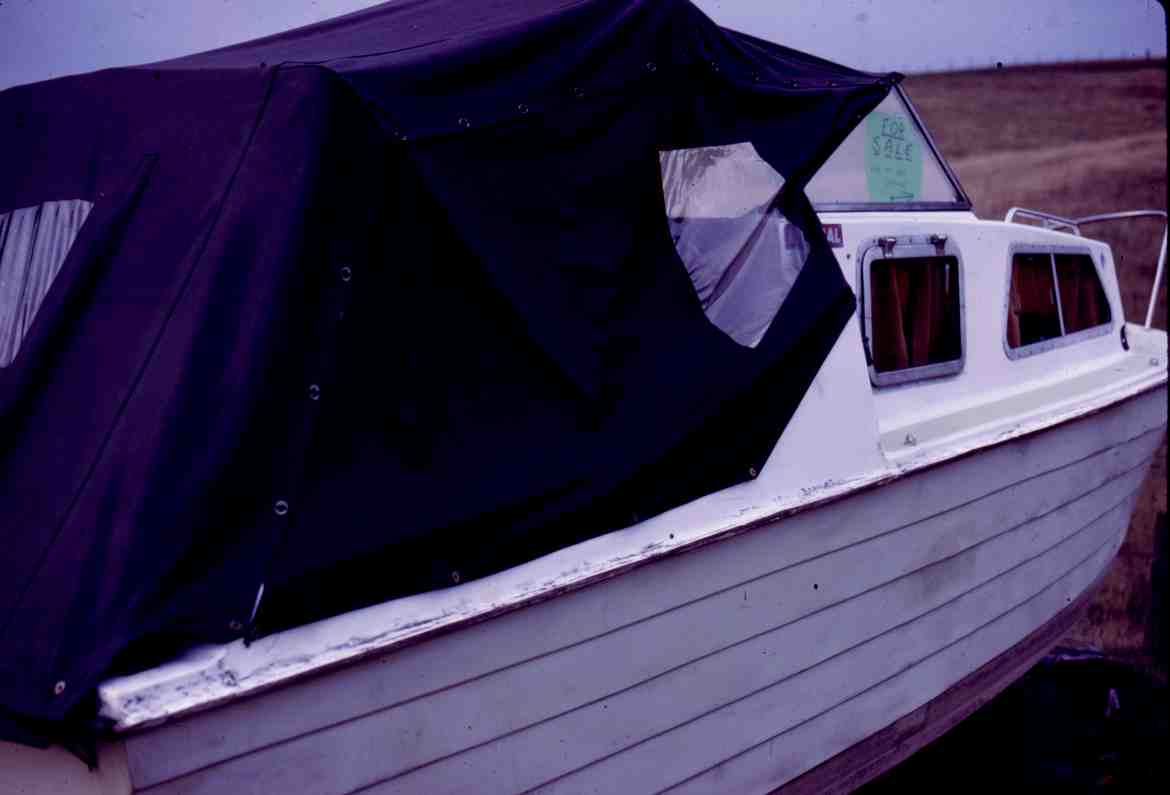
"Crazy Horse"... Complete with "For Sale" sign in the windscreen
It was a “Mystral 20” four berth, glass-fibre canal cruiser, with a light green hull and white superstructure, christened “Crazy Horse”. It was powered by a Chrysler 11 horse power two stroke outboard motor and was quite tidy inside with green PVC covering everything from the ceiling to the bunks. The boat needed some work though. The motor was suspect and I was told that the hull had Osmosis (a condition where the gelcoat… the outer layer of the glass-fibre, becomes porous). I was told that this condition could be easily remedied by rubbing down the hull, applying self-etch primer and a topcoat on top of it. What’s more, I could buy it as it stood for £500.
We immediately fell in love with the boat but not the name or the colour. So, after a family discussion, we decided to buy it. I asked Sid Merral if I could moor the boat below the Iron Lock and he said that I could. He also promised to build a new landing stage next to the slipway especially for me. On Wednesday 14th September 1983, we went to Beeston and paid Ken for the boat. Any spare time that we had over the next few weeks were spent rubbing down, painting the hull as previously described and changing the colour to white with a red water line. The name had to be changed and after another family conference, the name “Misty Waters” was decided on. The origin of the name was as follows… “Misty” after our dog and “Waters” after part of the name of one of my favorite canal boats of all time, a “Taylor” called “Quiet Waters”. Once the name had been decided upon the boat was registered with BWB, the self-adhesive number plates ordered and the licence obtained.
By Monday 26th September, “Misty Waters” was ready to be launched. The following Saturday, we took some friends to Beeston to help with the launch. All went well and there was no sign of water seeping into the bilge. Unfortunately, the outboard would not start so we pulled “Misty Waters” by rope to her new mooring below the Iron Lock. The following day, after an inspection and trouble-shooting session, I come to the conclusion that the engine was beyond repair. We went to Eggbridge Marine at Waverton where they had many second hand engines for sale, most of which were beyond our means. However, a Volvo Penta 140 caught my eye. This engine was very similar to “Phial’s” Crescent 18, being manufactured by the same company (Nymanbolagon AB, Uppsala, Sweden). As I was conversant with the Crescent and its workings, I thought that it would be suitable for our needs. Mister Smith, the owner of Eggbridge Marine, informed me that I could have it for £100. We settled on £70 with the defunct Chrysler in part-exchange and no guarantee.
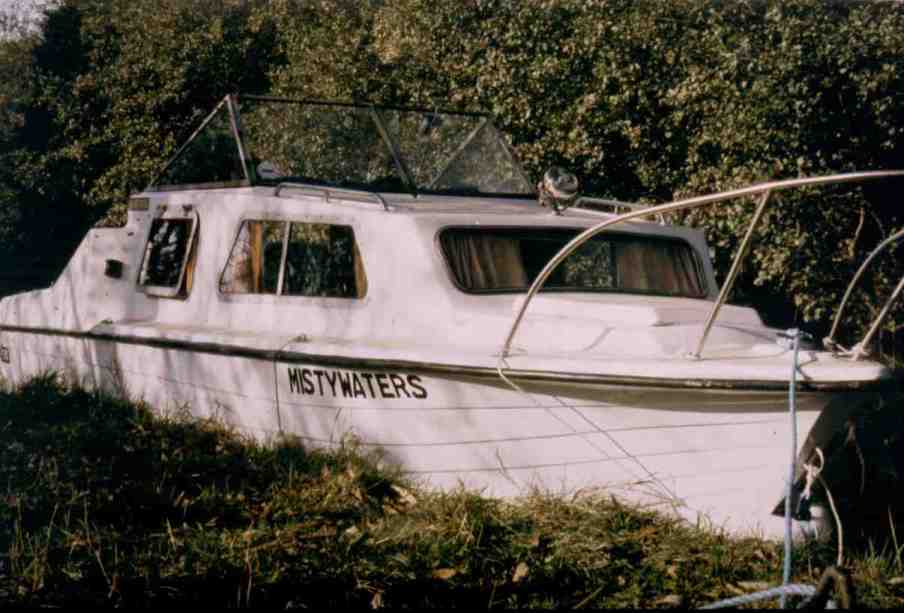
"Misty Waters" moored above Tilston Lock on the Shropshire Union Canal
The Volvo was fitted to the boat and started first time. Unfortunately, the gears would not engage, so I removed the engine and took it home to investigate. On stripping down the gearbox, I discovered a worn pinion gear to be the problem. I ordered a new gear set and seals, etc. from Pilkington’s, the Volvo Penta/Crescent dealers in Manchester, which arrived a few days later. They were duly fitted and everything appeared to be in order. In the meantime, I had fitted a full-wave rectifier to the engine’s small alternator (originally designed to produce a couple of amps, 12 volts A. C. to power navigation lights) to convert it into a D. C. charging unit for the battery, rewired the electrical system on “Misty Waters” and added items like a tunnel light, horn, extra interior lights, sockets, etc.
On Saturday 22nd October, the engine was fitted and worked perfectly so we decided to go for our first cruise. This was to Brockholes Aqueduct, where the River Gowy runs beneath the “Shroppie” between Beeston Castle and Tattenhall. We spent all night on board and even though she was a four berth cruiser, one of the berths was on the rear deck beneath the cockpit cover. This was not the most ideal of situations, especially as it was the end of October and quite cold. But sacrifices had to be made and one of them was my comfort. The following day, after I had thawed out, we cruised up to Bunbury before returning to our mooring. The next weekend, we returned to the boat to winterize both “Misty Waters” and “Phial”. We went up to Beeston regularly during the winter to make sure that no water had seeped into “Misty Water’s” bilge and also to ensure that “Phial” was alright.
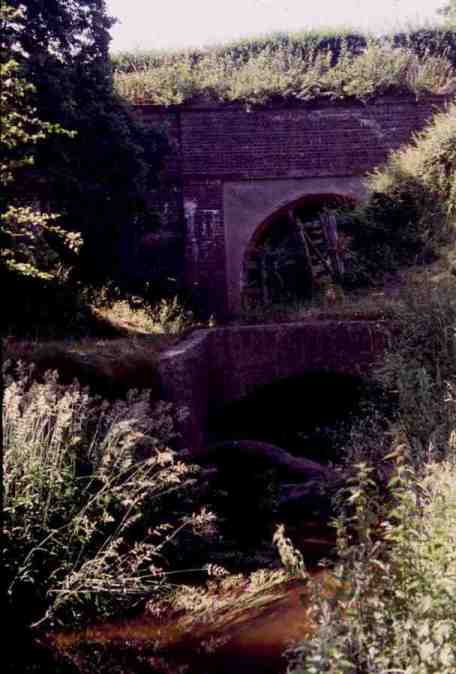
At Brockholes Aqueduct the "Shroppie" crosses a footpath which has the River Gowy running beneath it
I was quite concerned when British Waterways informed me that they were draining the pound between Beeston Iron and Wharton Locks. This drainage was necessary whilst Beeston Iron Lock was rebuilt due to subsidence… the reason the old Chester Canal had its terminus at Beeston for many years before Thomas Telford re-aligned the canal and built the present Beeston Iron Lock in 1828. This drainage meant that “Misty Waters” would be sitting on the bottom of the canal during the period of drainage. Mister Merral assured me that he would keep an eye on it, especially when they decided to refill the pound. My worries were unfounded and the boat was floating happily when we went up the weekend after the canal was re-filled.
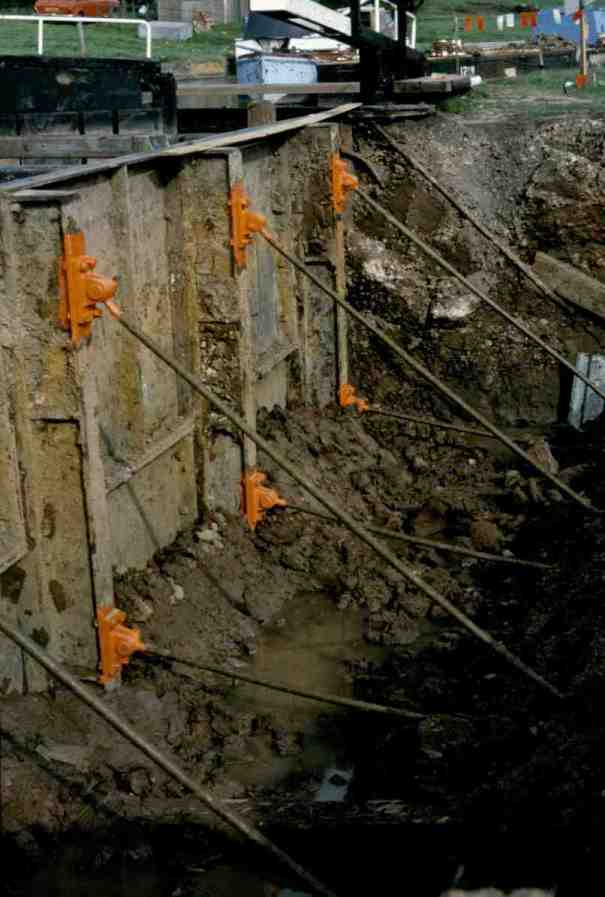
Repairs to the chamber supports of Beeston Iron Lock in 1983
In the spring of 1984, when we inspected “Misty Waters”, I was relieved to discover that my treatment of the hull had been a complete success with no sign of moisture in the bilge. The engine was behaving as it should and all the modifications made were successful. One more addition was the fitting of a transom guard. I had it made by my friend... Tony Holmes, who was a welder at Bidston Steel where we both worked. A holder for a flagpole was incorporated in the design as was a rubber “bumper” which had (literally) fallen off the back of a lorry at work. The flagpole itself was a broken mop stale that I had rubbed down, varnished and fitted with brass hooks to attach a pennant to. When the guard was fitted, our Inland Waterways Association pennant was fastened to the flagpole and very smart it looked too. Another friend... Malcolm Munro, who lives in our road, wound decorative rope around the tubular guard and we painted it white before it was fitted to the boat. We were now ready for our first holiday on “Misty Waters”. And, needless to say, we planned to cruise up the Llangollen Canal.
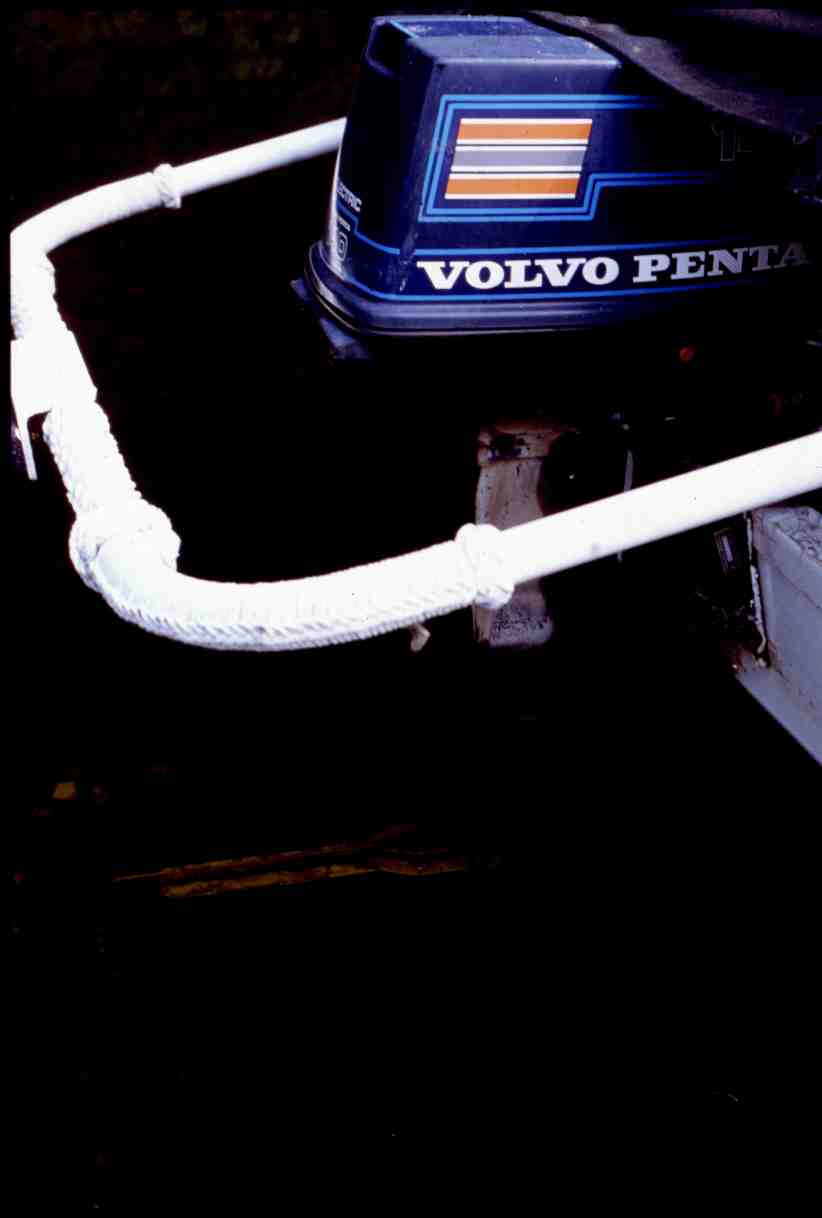
The Volvo Penta 140 and "Misty Water's" transom guard
Whilst mentioning Bidston Steel, around this time I had started writing my first manuscript... "Shroppie" about the Shropshire Union Canal. Cliff Law... the Personnel Manager at Bidston Steel wrote an article publicising my activities for the "Elkem Echo"... Bidston Steel's in-house magazine. I must admit that he used some "artistic licence" in the article which is reproduced below.

The article reproduced from the "Elkem Echo"
"Shroppie" was not completed as I lost enthusiasm for it when somebody else beat me to it and published a book by the same title (which I have in my library of canal books). Subsequently, the project was filed away and didn't see the light of day until recently when I dusted it off, scanned the text into the computer and up-dated it. It is included elsewhere in this series of eBooks and website ("Shroppie" - The Shropshire Union Canal System).
But back to our holiday on the Llangollen Canal. The weather on this holiday was exceptionally warm, so I did not object to sleeping in the cockpit. The engine was proving to be extremely reliable, starting on the first turn of the key and showing little sign of fouling the sparking plugs. It was more economical than the Crescent 18 on “Phial” as it was slightly smaller being fourteen horsepower against eighteen and only had one carburetor compared to the Crescent’s two. It was also significantly lighter and quieter into the bargain.
Sunrise at Calveley on the "Shroppie"
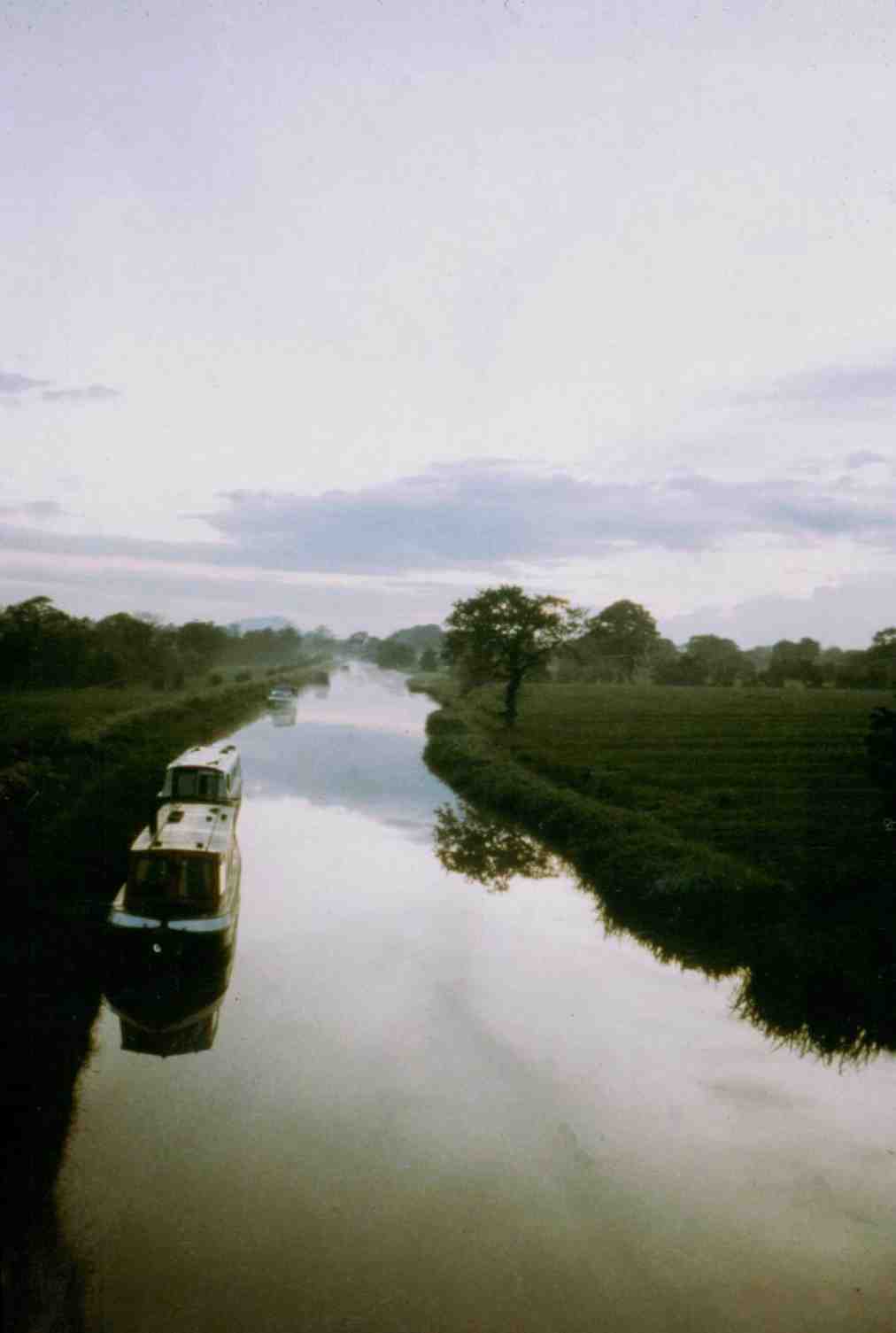
And the view in the opposite direction... "Misty Waters" (literally) is the third boat down
So, with the fuel tank full to the brim, the cupboards filled with food and our clothes, belongings, etc. (and plenty of "Kodachrome" transparency film for the Olympus OM1n) loaded on board we set off for Llangollen. The weather was good to us and we cruised up to Hurleston in brilliant sunshine. When we were out cruising, my children delighted in the things that I used to do when I was their age. Things like running up the brickwork slopes surrounding the pipes at Baddiley Wharf or standing on the roadway of the lift bridges as they descended, not to mention operating locks. Even though my children are now grown up, they still remember the fun that they had following in my footsteps.
My youngest son - Glyn running up the aforementioned pipes at Baddiley in 1984
We made good time and tied up for the first night at Baddiley beneath the willow trees on the off-side of the canal. The following morning we set-off early and reached Ellesmere that afternoon. We crossed “Ponty” the next day and were tied up in Llangollen by lunchtime. I was dismayed to discover that craft (except for the horse-drawn pleasure craft and canoes) could not navigate all the way up to the Horseshoe Falls at Llantisilio. Instead, they have to turn around at the winding hole just after Llangollen town moorings where the marina entrance is today. British Waterways had installed concrete humps in the bridge holes to prevent deeper drafted craft from proceeding past the winding hole (now the location of new marina-style moorings). So, we walked. The children off a steel cabin cruiser called “Rakaia” (named after a river in New Zealand and also the name of a full-rigged, 1022 ton sailing ship built in 1873) moored close to ours, made friends with my children and accompanied us to the Horseshoe Falls. Their parents, Edna and Paul Gourdji from Saint Helens, came along as well. Following the children’s’ example, we made friends with the Gourdjis who accompanied us for the remainder of our holiday. We had a good time as well. We stayed up late playing cards on the rear deck of “Rakaia” and laughed at the "man with a hat"... who was really the shadow cast by the boat's rear cleat. A couple of days later the children spent many happy hours dancing to Black Lace’s “Agado” (a song that was in the pop charts at the time) on the towpath and we all shared a barbeque on the canal bank near the A5 at Whitehouse.
Chirk Aqueduct at sunset
On the way back down the “Shroppie”, “Rakaia” developed engine trouble. Its diminutive, single cylinder Petter diesel engine lost compression and we ended up towing them to Beeston. Once there, I arranged for their boat to be left on Mister Merral’s moorings, and ran Paul to Preston Brook Marina to collect his car. He planned to remove the engine from his boat, repair it, and bring it back the following weekend. This he did, and to ensure that they were alright, we accompanied them as far as Broken Cross on the Trent and Mersey Canal before turning around and heading back to Beeston whilst they carried on to their moorings at Preston Brook Marina on the Bridgewater Canal.
Bridge 107 at Beeston photographed from our moorings
We kept in touch with the Gourdji family and, as they didn’t live too far away from us, we visited each other’s homes. We scheduled our next year’s holiday (1985) to coincide with theirs and planned to meet below King’s Lock on the Trent and Mersey Canal at Middlewich. We planned to cruise the “Four Counties Ring” together with an excursion down to Stourport on Severn if time allowed.
In July 1985, I was made redundant from my job in a steel mill. With some of the redundancy money we decided to buy another boat. As Peter Smith at Eggbridge Marina had been so fair with us in the past, we decided to pay him a visit and see what he had on brokerage. One weekend in July we cruised down to Waverton in “Misty Waters” and saw a brown and beige Dawncraft Dandy he had for sale. The boat didn’t have an engine but I wasn’t too concerned about that as I could take the Volvo and its wiring loom off “Misty Waters” quite easily. We looked over the boat and decided to buy it provided that a suitable deal could be struck. After some haggling, we agreed on £1000 with “Misty Waters” taken in part-exchange and my swapping the engine over. The following weekend we cruised down to Waverton and after the formalities, I gave Peter a cheque for the required amount. We then transferred the engine and our belongings to the new boat before returning to our moorings at Beeston.
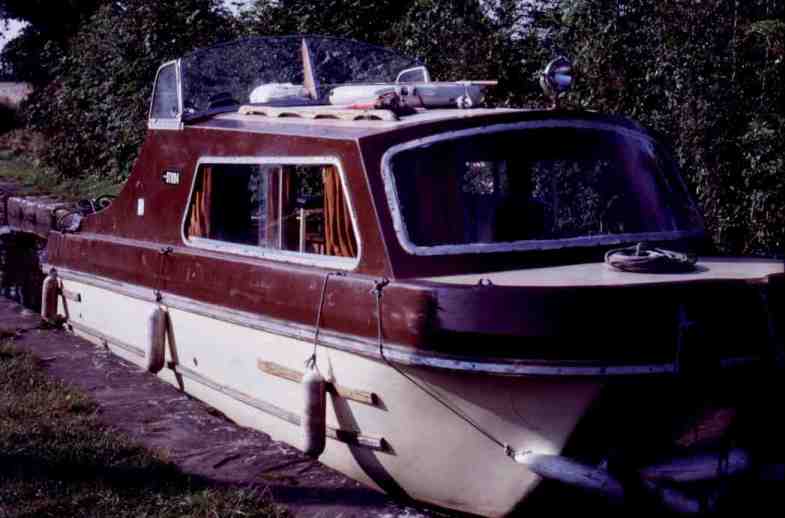
"Misty Waters 2" shortly after being purchased
As well as the engine, the name was also transferred. Even though technically, the new boat was “Misty Waters II” we dropped the “II” from the name. The new “Misty Waters” was a revelation. It had much more room than the Mystral even though it was the same length. The layout was more sensible in its utilization of the available space, having two single bunks in “tunnels” (quarter berths as they are known) beneath the rear deck and a bed that was the whole width of the boat when an additional board and mattress was added in the centre. It boasted a larger water tank, a cooker with an oven and best of all… I didn’t have to sleep on the rear deck.
We didn’t tell the Gourdjis about our new boat and planned to surprise them when we met up at the start of our holidays. In the weeks leading up to the holidays, “Misty Waters” was rewired, given a fresh coat of paint and various modifications made which all helped to personalize the boat.
It didn’t seem long before we were setting off on our holidays and heading down the Middlewich Branch of the “Shroppie”. The weather was sunny and we made good time, arriving at our meeting point well ahead of schedule. Whilst we waited for our friends, we went into the town to buy some essential provisions and on our way back we saw “Rakaia” rising in lock number 75. The children helped them through the lock and soon, they were approaching us still unaware that the boat had changed. As they drew level, I popped out of the cabin to surprise them. They moored behind us and came to admire the boat. Soon after this, we set off up the Wheelock Flight and the notorious “Heart Break Hill”.
In true British fashion, the weather changed for the worse and it started to rain. Undaunted, we donned our waterproofs and continued locking. One of the landmarks that I had been looking forward to seeing was Thurlwood Steel Lock. This lock was similar to Beeston Iron Lock inasmuch that they both had chambers constructed from materials that are not normally associated with lock chambers (iron at Beeston and steel at Thurlwood) due to the instability of the ground beneath them. But that is where the similarity ends as the reason behind Thurlwood’s unique construction was due to subsidence caused by the intensive salt mining common to the area and not running sand as with Beeston. There were other features regarding the lock’s construction that were worthy of note, such as the “guillotine” style gates, the interlocking bars running the length of the chamber that prevented the top and bottom gates being raised at the same time, the exposed pipe work for filling and the fact that the whole construction was mounted on jacks to overcome future subsidence. Fortunately, the rain eased off long enough for me to take photographs of the lock but started again not long afterwards. I was glad that I photographed it as it was dismantled in 1988. After the interlude at Thurlwood we continued through the Lawton flight of locks and tied up for the night at Church Lawton.

Thurlwood Steel Lock
The following day we passed through Kidsgrove and at lunchtime arrived at Harecastle Tunnel. The weather had been showery on our approach to the area and whilst we waited to pass through the tunnel the showers abated and I took the opportunity to take photographs. With the outboard being a “two-stroke” it was prone to “plug fouling” when ticking over or running at low speeds. A lesson that I had learnt from Father was to use slightly “hotter” spark plugs if prolonged slow running was envisaged. This I did but I still didn’t relish the thought of being stuck behind a narrowboat as the last place I wanted the plugs to “foul” was in the middle of Harecastle Tunnel.
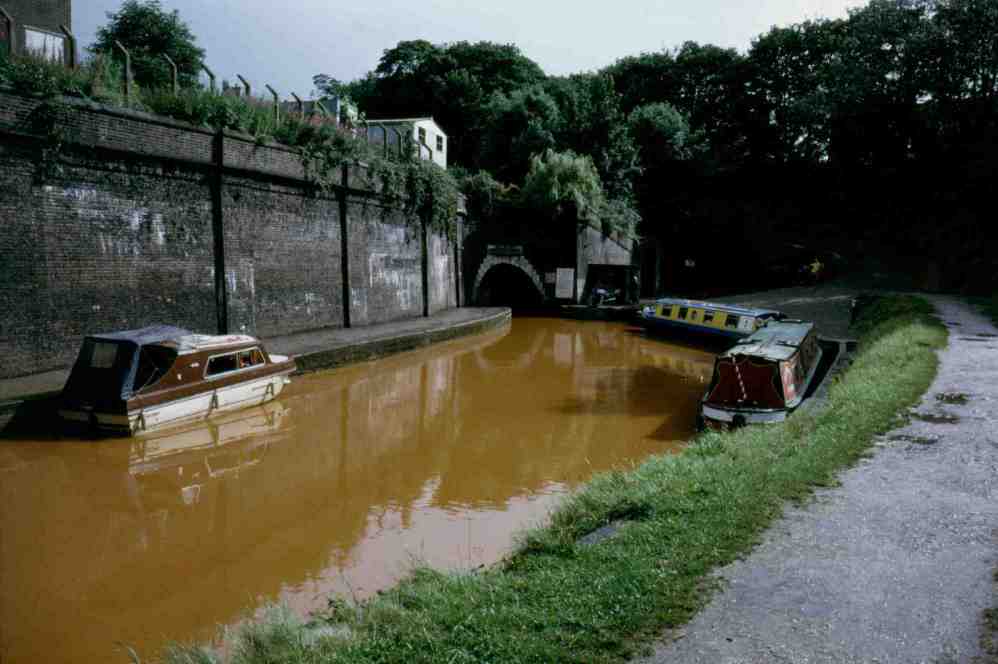
"Misty Waters 2" waiting to pass through Harecastle Tunnel, July 1985
I approached the tunnel keeper and explained the situation to him and asked if we could go through first to which he agreed to. At last, the doors opened and it was time for us to enter. Only we didn’t. He waved a boat in before us and guess what it was? It was a sixty foot narrowboat complete with its solid fuel fire burning (in the middle of summer?). Still, I thought that they might open their throttle a bit once they were in the tunnel proper, which meant that we could go a bit faster and, in turn, allow our spark plugs to stay clean. They didn’t. The passage through the tunnel was at tick-over pace for us and made all the worse by the smoke from their fire. Next minute, you guessed it, after only a third of the way through, the Volvo went onto one cylinder and a couple of minutes later onto none. I switched on the fluorescent light that I had installed to illuminate the rear deck and engine bay and started to change the plugs.
Halfway through the operation, “Rakaia” caught us up. We flashed the torch to signal that we were stationary and they came to a stop right behind us. Paul called to ask what the problem was and after I shouted “Plugs” continued with my labors. I dropped one of the spark plugs into the water due to it still being very hot as I removed it. The job was soon accomplished and the engine started on the first turn of the electric starter. By now, the narrowboat was quite a way in front of us which allowed me to open up the throttle a little to prevent a reoccurrence of the problem. I couldn’t go too fast as the towpath had not completely been removed at this time and I had to keep a look out for the remaining sections. We still caught up with the narrowboat in front before exiting the tunnel though and we went onto one cylinder just before we reached daylight.
After emerging from the tunnel we pulled into the towpath and changed the spark plugs once more whilst we waited for Paul to emerge. As we did so, the sun went in and it started to rain again. Ten minutes later, we cast off and followed “Rakaia” up to Longport were we tied up for a cup of tea and a snack. The rain started to fall more heavily and we decided to stay there the night. Next day Paul couldn’t start his engine so we spent it at the aptly named Longport whilst he fixed it. He thought that he had water in the fuel caused by all the rain we had. The problem actually lay with the injector, which he removed and took it to be cleaned and re-set at a nearby diesel engine specialist.
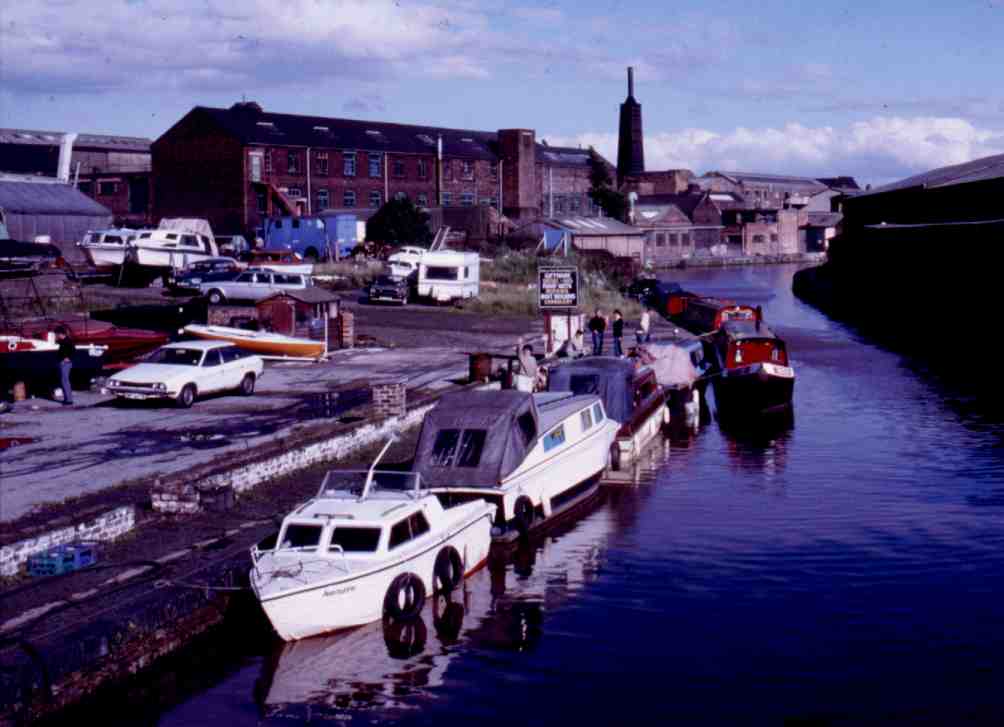
|
Longport - Stoke on Trent... "Misty Waters" is the |
|
third boat from the camera with "Rakaia" the fourth |
The Trent and Mersey Canal at Stoke on Trent complete with a bottle kiln on the right
The next day, it had stopped raining but was still overcast. With Paul’s engine now behaving itself we cast off. We soon passed through the Shelton Steel Works, past the junction with the Caldon Canal and cruised non-stop for the rest of the day to try and make up some of the lost time. The following day we also cruised non-stop and that night, we moored in Tixall Wide on the Staffordshire and Worcestershire Canal where we had a barbeque on the canal banks. It was a magical place for as darkness fell the mist started to rise and we watched it creep across the water as we ate our hot dogs and burgers.

Dismantling Shelton Steel Works - Stoke on Trent in July 1985
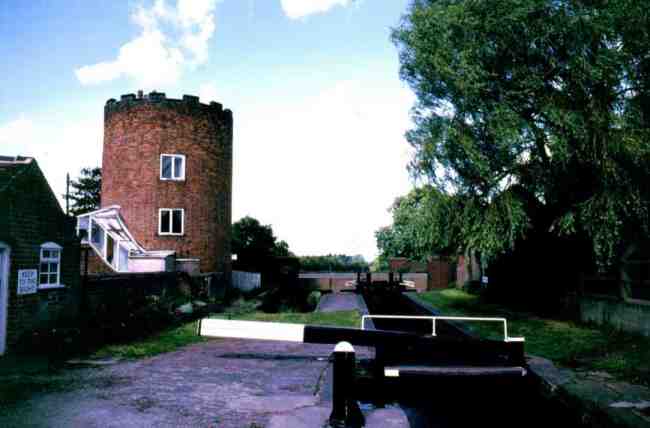
Gailey Lock and Round House beside the A5 on the Staffordshire and Worcestershire Canal
The next day dawned bright and sunny. We made an early start and continued towards Wolverhampton. I was captivated by Gailey Lock and its unusual round lock cottage. They are normally found on canals such as the Thames and Severn and in fact the round lock houses on the Staffs and Worcs where the inspiration behind those on the Thames and Severn. I seem to recall seeing the remains of one further down the Staffs and Worcs at Gothersley as well. It was decided to carry on along the canal and see how far we could reach. We had originally planned to try for Stourport but we didn’t think that, with the unscheduled stoppage at Longport, we would have enough time for this.
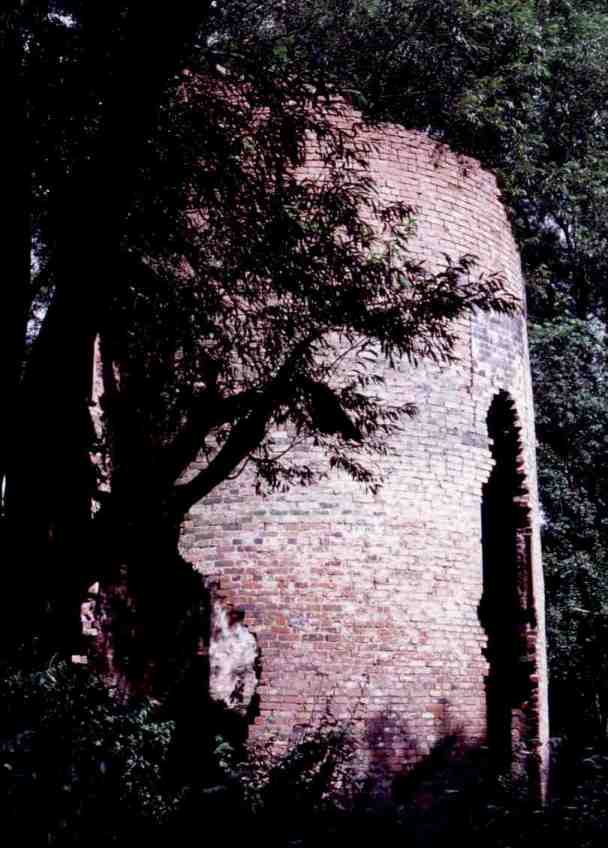
Gothersley Roundhouse on the Staffordshire and Worcestershire Canal
Grub Street Cutting on the "Shroppie" with Rocket Bridge in the distance
We were correct in this assumption and managed to reach Kinver before we had to turn around. We spent half a day there basking in the brilliant sunshine before we set off for the more familiar waters of the “Shroppie”. The weather was mixed and it alternated between bright sunshine and rain. At Market Drayton we moored at the now defunct site of the Ladyline marina. Even though the boat chandlery and sales had closed down, boats still moored further down the canal. Fortunately, when we reached Audlem the weather was sunny.
The picturesque Tyrley Cutting and Locks outside Market Drayton
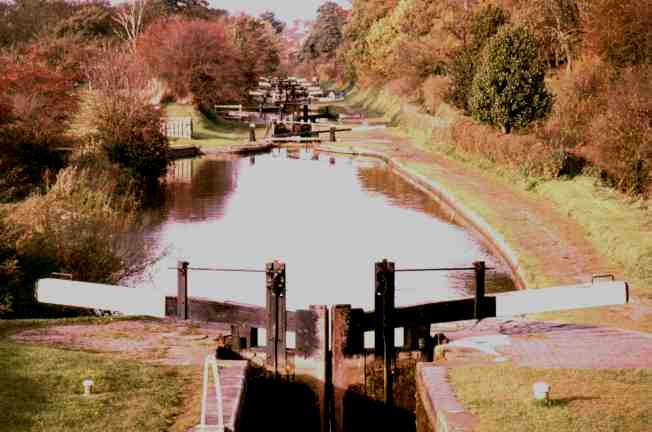
Looking down the Audlem flight of locks
It was on this occasion we negotiated the complete Audlem flight of fifteen locks in less than two hours… one hour fifty minutes to be precise, and that included having to wait at one of the locks half-way down the flight to pass a boat coming up the flight. After passing through all the locks we moored at the bottom of the flight close to the River Weaver Aqueduct and paid a visit to the shops in the village as well as the Shroppie Fly and Audlem Craft Shop. There were no further problems during the rest of the holiday and we bade our friends farewell at Barbridge Junction where they headed for Middlewich and we carried on down the “Shroppie” to our moorings at Beeston.
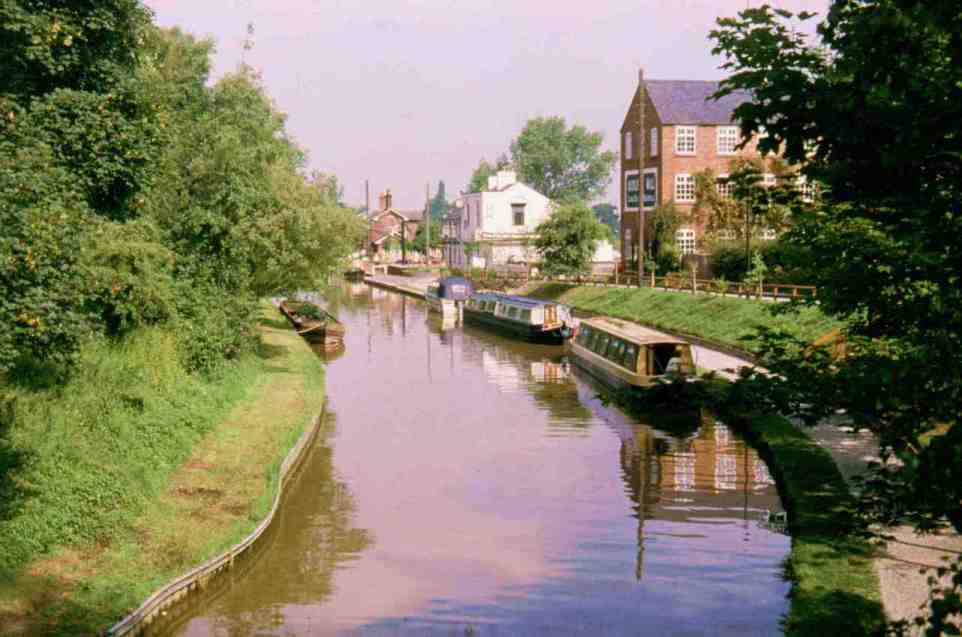
Audlem looking towards the "Shroppie Fly" from lock 12
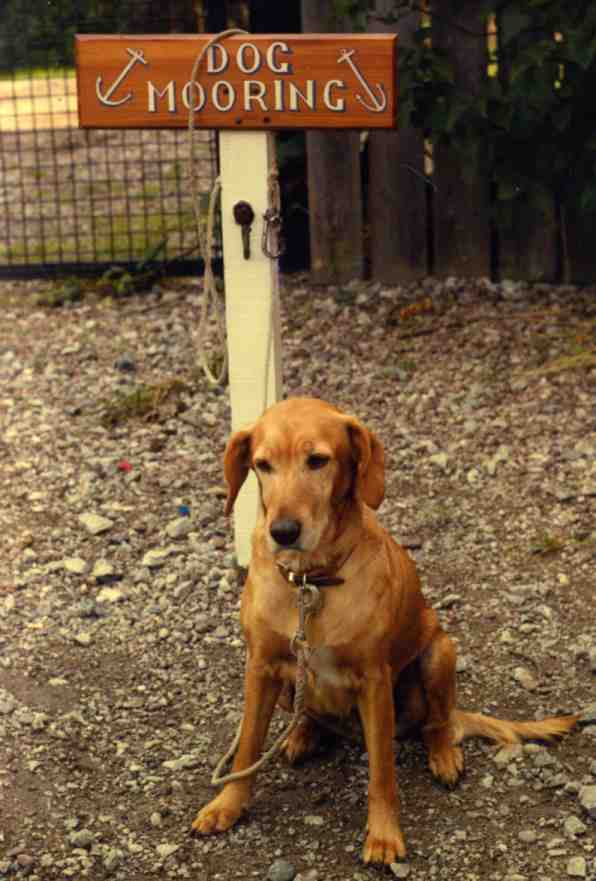
Misty at the "Dog Mooring" next to Audlem Mill
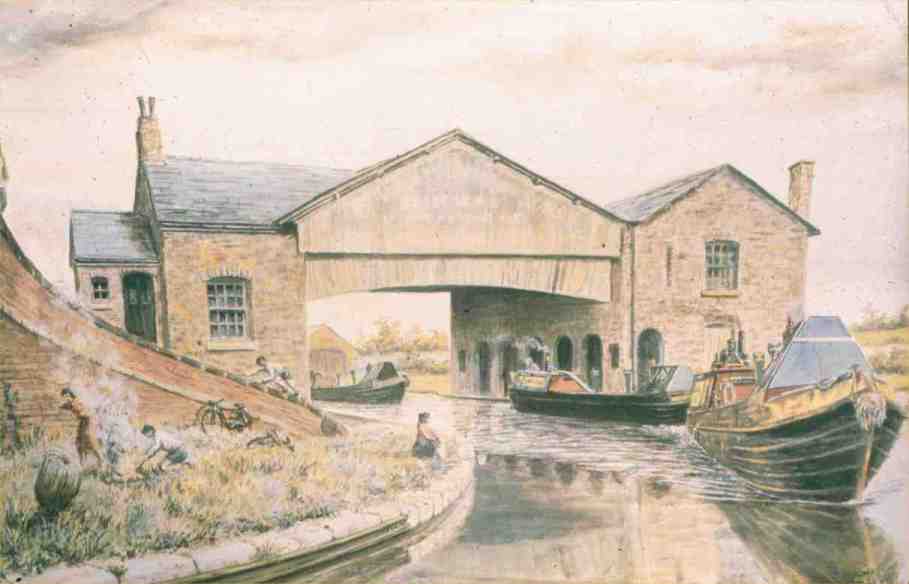
A painting by an unknown artist of Barbridge Junction showing the warehouse that spanned the "narrows"
During the holiday, Paul suggested that we might like to consider moving our moorings to Preston Brook Marina on the Bridgewater Canal. He explained that the Bridgewater Canal licence was cheaper and would offset the dearer mooring charges at the marina. He also promised that we would make many new friends in addition to enjoying cruising on the Bridgewater Canal, as it was a deep, broad waterway that didn’t have any locks. The children didn’t take too kindly at this idea as they enjoyed being at Beeston and liked operating locks, which the “Shroppie” had in abundance. We said that we’d think about it but our minds were made up when we were invited to a cruise with one of Paul’s friend’s. Paul’s friend was Dave Reed and his boat was called “Cordelia”, a forty-foot Hancock and Lane narrowboat on which we cruised from Preston Brook to Lymm and back. I installed myself on the foredeck of “Cordelia” with my Olympus OM1n and documented the trip photographically. Even though the weather wasn’t particularly warm, we had seen enough to decide to move our mooring. After making the necessary arrangements with the marina and the Manchester Ship Canal Company (who own the Bridgewater Canal) for the licence, the next Saturday we set off from Beeston for the last time.
|
A cast iron bridge guard on a Shropshire Union Canal bridge |
|
used to protect the masonry against rope induced friction |
We moored for the night at Billinge Green Flash below Middlewich and continued the next morning. We passed the then closed and dilapidated looking Anderton Boat Lift, passed through Barnton and Saltersford Tunnels and were amazed at the size of the lake between the tunnels. The canal wound along the side of the River Weaver Valley to Dutton Stop Lock, which we thought was a pitiful excuse for a lock (as is Autherley Stop Lock at the end of the “Shroppie”) and entered Preston Brook Tunnel which we passed through without incident. Whilst in the tunnel we admired the new concrete section where the tunnel had been rebuilt in 1982 following a partial collapse that isolated the Bridgewater Canal for a couple of years whilst rebuilding took place.
It was when we reached the Bridgewater Canal that the problems occurred. A little way on from Preston Brook Tunnel, for no apparent reason, the drive from the engine was lost. The engine was running but would not engage forward gear although we still had reverse. It was a good job that it didn’t happen a few minutes earlier inside the tunnel. I turned the boat around and reversed the remaining half-mile to the Marina. Paul and his family met us at the marina entrance and I reversed onto the same pier as “Rakaia”.
And so started a new chapter in my canal boating biography located on the Bridgewater Canal. This new chapter was to see many changes, not only to my interest in boating but also to my personal life. At the time, not all these changes seemed to be for the good, but with hindsight, I would not change any of them.
Chapter 2 -
Bridgewater Days
Once we had settled in at our new mooring on Preston Brook Marina, my mind turned to the matter of the engine. I suspected that the main thrust bearing had gone in the gearbox, which caused it to lose forward gear. The engine was removed from the boat and put in the car (after Paul ran me back to Beeston to collect it) and taken home. Later that week, I stripped down the gearbox and was relieved to discover that my suspicions were correct; the main gearbox thrust bearing was virtually non-existent. This in turn prevented the dog-clutch from engaging in the forward gear. The following day a replacement was ordered from Pilkington’s which was dispatched immediately and by the following weekend, the fully operational engine was refitted to “Misty Waters”.
| The Bridgewater Canal at Moore with the tower of |
| Daresbury Laboratories just visible in the background |
For our first weekend cruise on the Bridgewater Canal, we cruised to Moore, not far from Daresbury with Paul, Dave Reed and another new friend… Alec Levac. Alec’s boat, “Tamar”, was beautiful. It was a replica of a 48ft B.C.N. Tug built by Chris Lloyd (of “Waterways World” fame) and powered by the biggest engine I have ever seen in a canal boat… a thirty-eight horsepower, pre-war, Dorman marine engine. But this wasn't the first time that I had seen "Tamar". I remember reading an article in "Waterways World" about CB Radio and canal users. I cannot remember if the article was written by Chris Lloyd but I do remember seeing "Tamar" in the background of the photographs. Anyway, on this first weekend cruise on the Bridgewater Canal I started to become acquainted with my new friends and also started taking photographs of this under-rated canal.
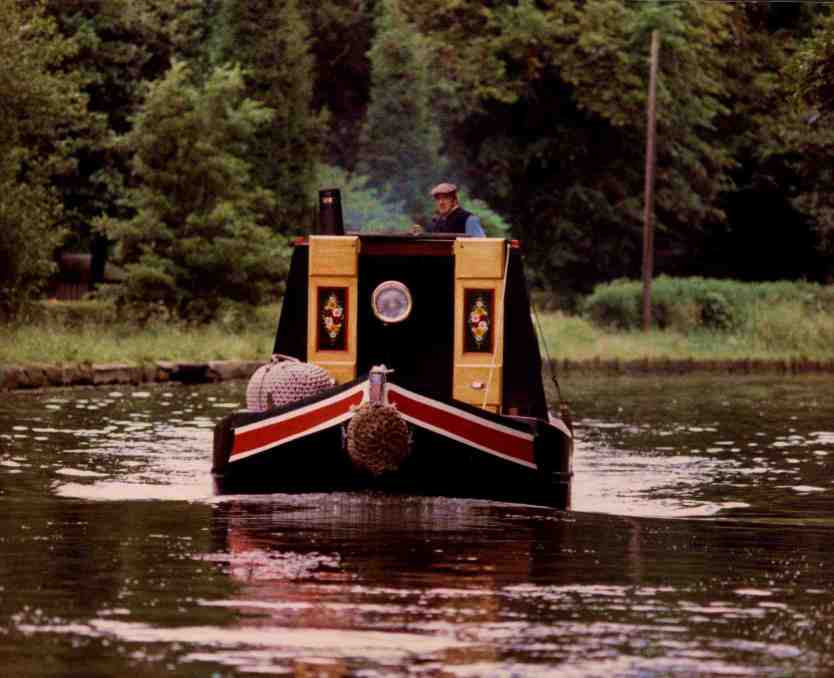
Alec Levac at the tiller of "Tamar" on the Bridgewater Canal at Grappenhall
It was soon Halloween weekend, and a cruise had been arranged to Worsley by the “Preston Brook Boat Owner’s Association” (P.B.B.O.A.), with the main activities taking place on the Saturday night. Paul, Alec and I left the marina on the Friday evening, travelling in the dark before mooring at Lymm for the night, leaving early the next morning. Dave had left before us and when we reached Worsley we discovered that he had already arrived. His boat was locked up and we presumed that he had gone over the road to the Bridgewater Arms for a drink.
Later on, when the activities started, a strange man dressed like a tramp came along the towpath approaching the ladies in our party. I asked him to go away but he was most persistent and it wasn’t until a few minutes later, after I had come close to pushing him into the canal that we discovered it was really Dave dressed up as a tramp.
The Packet House at Worsley
Over the next few weeks, prior to the end of the season, we had many enjoyable outings such as this and the last scheduled open-air event was a Bonfire Night party on the marina organized by the P.B.B.O.A. As well as burning everybody’s combustible rubbish, an old boat went on the bonfire as well. The bonfire was supplemented with fireworks and a barbeque.
Even though the boating season had come to an end, the activities on the marina hadn’t. I was asked to give a slide show at the annual P.B.B.O.A. Christmas dinner at Preston Brook Village Hall. I showed slides that I had taken on the Shropshire Union and Llangollen Canals in the first half of the show and the Bridgewater Canal in the second. In those days I was only using one slide projector with a “wild” synchronized soundtrack containing suitable “Classic Rock” music played by the London Symphony Orchestra. It was a great success and was to be the first of many such shows given to various canal societies up and down the Bridgewater Canal as well as travelling as far afield as Birmingham in the South and Manchester in the North.
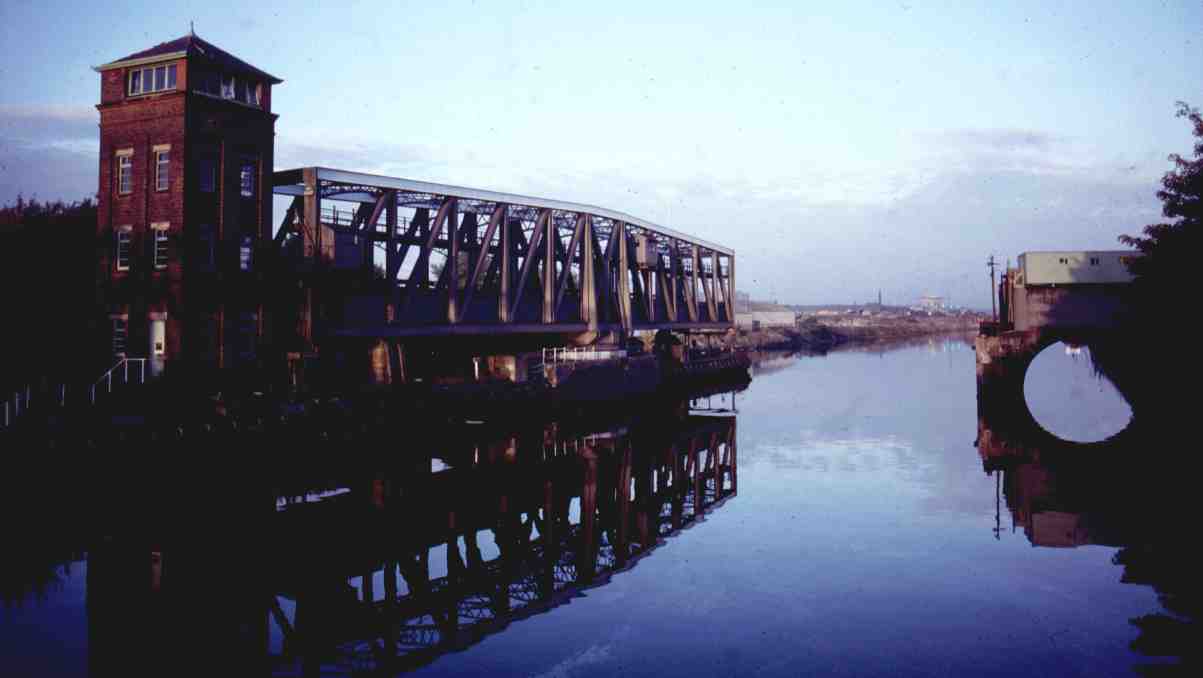
Barton Swing Aqueduct swung to allow the passage of craft on the Manchester Ship Canal
At the AGM of the P.B.B.O.A. I was voted onto the committee as an ordinary Committee Member. The Chairman at the time was Dave, a structural draughtsman from Liverpool. He and his wife Joyce (who was a school teacher) and their two young boys were regular cruisers on “Cygnet”, their Dawncraft Twenty Five. He was a jovial man and made many analogies when describing something. One that I remember was when he was talking about something that was too large to fit somewhere and he analogised it as “Big box… small room”! After I had written the script for "The Duke's Cut" audio/visual presentation commentary and its subsequent conversion into a manuscript I gave David and Joyce a copy (which they still have and cherish) not thinking that one day I would be signing a copy of the book that it was to become. Dave and Joyce are still cruising the Bridgewater Canal only they now have “Amy”… a fifty two foot narrowboat that was built especially to their own design by John White Narrowboats. They have recently joined Lymm Cruising Club and when I remind him about “big box, small room” we all start laughing.
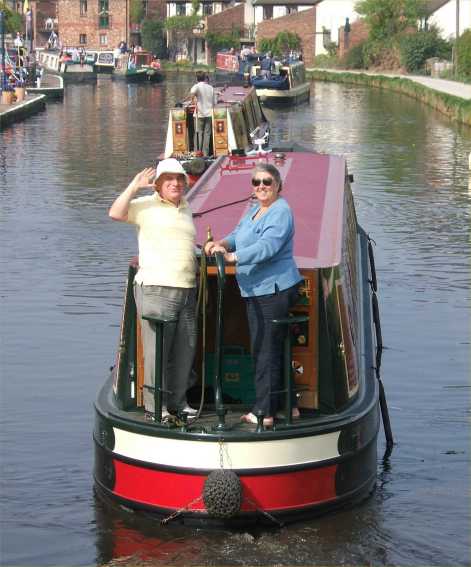
A recent (2007) photograph of Joyce and David Stewart aboard NB Amy
There was one incident that occurred that winter that I would rather forget. The ceiling and interior of “Misty Waters” was covered in expanded polystyrene tiles. Not only were they unsightly but flammable as well. I had decided to cover the interior with a thin brown carpet. The logical way to attach the carpet was to use impact adhesive. It was a long, messy job and took many hours of patiently cutting the individual pieces to fit, then gluing them onto the exposed glass fibre inside the boat.
A sunken barge at Boothstown Pen, now the location of The Moorings pub, Bridgewater Marina and a housing development
I went up to the marina many times in the evening after work in order to complete the task more quickly. On one particular Thursday evening, I was covering the sides and top of the two rear bunks that ran in “tunnels” beneath the cockpit. It was extremely cold and I had left the door open in order to help keep the fumes from the adhesive down to a reasonable level. The boat must have rocked and the door closed without my noticing. Consequently, the fumes built up and I became unconscious.
That evening, Dave and Alec had also come up to the marina to do some jobs on their boats. They noticed that the lights burning on “Misty Waters”. She was also leaning over slightly to one side indicating that someone was aboard. They called out to me but, as I was unconscious, could not hear them. They decided to investigate and I was discovered, collapsed inside one of the bunk “tunnels”. I was immediately brought out into the fresh air and Alec went to telephone for an ambulance called. A telephone could not be found so I was bundled into Dave’s van and they rushed me to Runcorn Hospital, about two miles away. Whilst on the way, Dave was stopped for speeding by the Police, but when they knew of the circumstances, they gave us an escort to the hospital.
I came to in a delirious state as Runcorn Hospital was reached. The doctor insisted that I stay the night at the hospital for observation and was well enough to drive home the following morning. If it hadn’t been for the quick thinking of Dave and Alec I might not be here to tell the tale. I now always treat substances that give off a heavy vapour with respect and ensure more than adequate ventilation when using them. When I was completing the carpeting a few days later, Alec and Dave insisted that there was someone present, talking to me all the time to prevent a reoccurrence.
The narrowboat "Sarah" having her sign writing completed at Moore
As previously mentioned, the new “Misty Waters” was a revelation but, as anyone who has owned a Dawncraft Dandy will testify, the Dandy was easily caught by the wind due to, no doubt, the shallow draft. I decided to do something about this and placed bags of ballast beneath the front cabin floor which was reached via a narrow gap beneath the front bunks. I must have placed about a quarter of a ton of ballast in the boat, sufficient to prevent the boat from having its normal bow-high stance. This was so successful that as well as lowering the boat’s susceptibility to side winds it also increased stability and straight line steering. The only drawback was that the draft had increased to over one foot but, as a friend of mine once said… “There’s no such place as Utopia”!
I had decided to take “Misty Waters” out of the water for the winter to clean and inspect the underside of the hull and repair some accident damage to the bow that the previous owner had not completed to my liking. The opportunity was also taken to paint from the rubbing strip down with red two-pot polyurethane paint. A trailer was borrowed from someone on the marina and the boat slipped out. It was towed to the opposite side of the marina where there was hard standing. The hull was completely cleaned and left to dry-out.
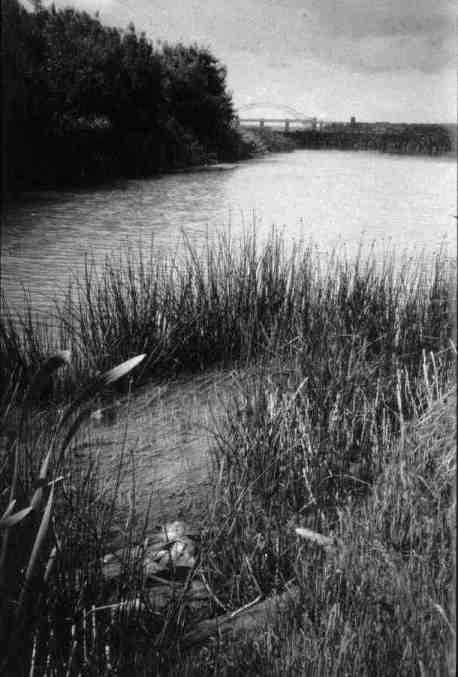
|
Not a cruisable canal but the remains of the disused Runcorn and Latchford Canal... |
|
parts of which were obliterated when the Manchester Ship Canal was constructed |
Whilst the boat was out of the water, it did not stop our cruising activities. Mike Webb, manager of the Manchester Ship Canal Company’s Bridgewater Department, had approached Alec and asked him if he would like to tow a full-size Bridgewater barge (Works Float No 3 or WF No 3 for short) from Worsley to Runcorn with “Tamar”, a task that the craft was ideally suited to do. Alec naturally said yes to Mike Webb and also asked us if we would like to come along to help. We also said yes and were recruited into “Alec’s Barge Moving Crew”. We went up to Worsley on the Saturday and found the barge easily. “Tamar” was winded and we tied-up for the night next to the barge adjacent to the footbridge. The next morning, we were up early, had our breakfast and prepared for the long haul back to Runcorn. I was designated as the steerer of the barge, we then connected a towing line between both craft and off we went.
My eldest son... Michael mooring Works Float No 3
At first, I was a little apprehensive about passing moored craft, especially the fibreglass cruisers on linear moorings. We passed through Worsley and Patricroft without any incidents to be confronted by our first obstacle… Barton Swing Aqueduct. The aqueduct was negotiated without any problems although it was a little tight width-wise. The wide, clear waters of Trafford Park were lined with fishermen, obviously disgruntled by “Tamar’s” wash as the engine was working quite hard pulling the barge. Fortunately, we did not meet many craft out cruising and what few we did meet were very sympathetic to the lack of manoeuvrability and gave us a wide berth.

The view from the tiller of "Works Float No 3" with "Tamar" towing it past Norton Priory
When a cup of coffee and sandwiches had been prepared, Alec eased off on the speed wheel and the barge slowly crept up to “Tamar’s” counter, making sure that the tow-rope was kept well clear of the propeller. My two sons; Michael and Glyn, were my crew on the barge and my daughter Lisa, who was crewing for Alec, handed them the refreshments. It was a bit of a stretch from the rear deck of “Tamar” to the high front deck of the barge but we managed it without too much spillage. Night was falling when we finally reached Runcorn. We moored the barge just after BMBC's Sprinch moorings and with all of us on board “Tamar” returned to her mooring on Preston Brook Marina after a job well done. So successful was the exercise that we were asked on many occasions to move barges as well as one of the Bridgewater Canal’s full-length butty boats to various locations along the canal and each was as enjoyable as the first. Whilst steering the barge I was surprised how quickly other boaters get out of the way when they see a full-size Bridgewater barge under tow heading for them… a luxury that I wasn’t used to with the diminutive “Misty Waters”!
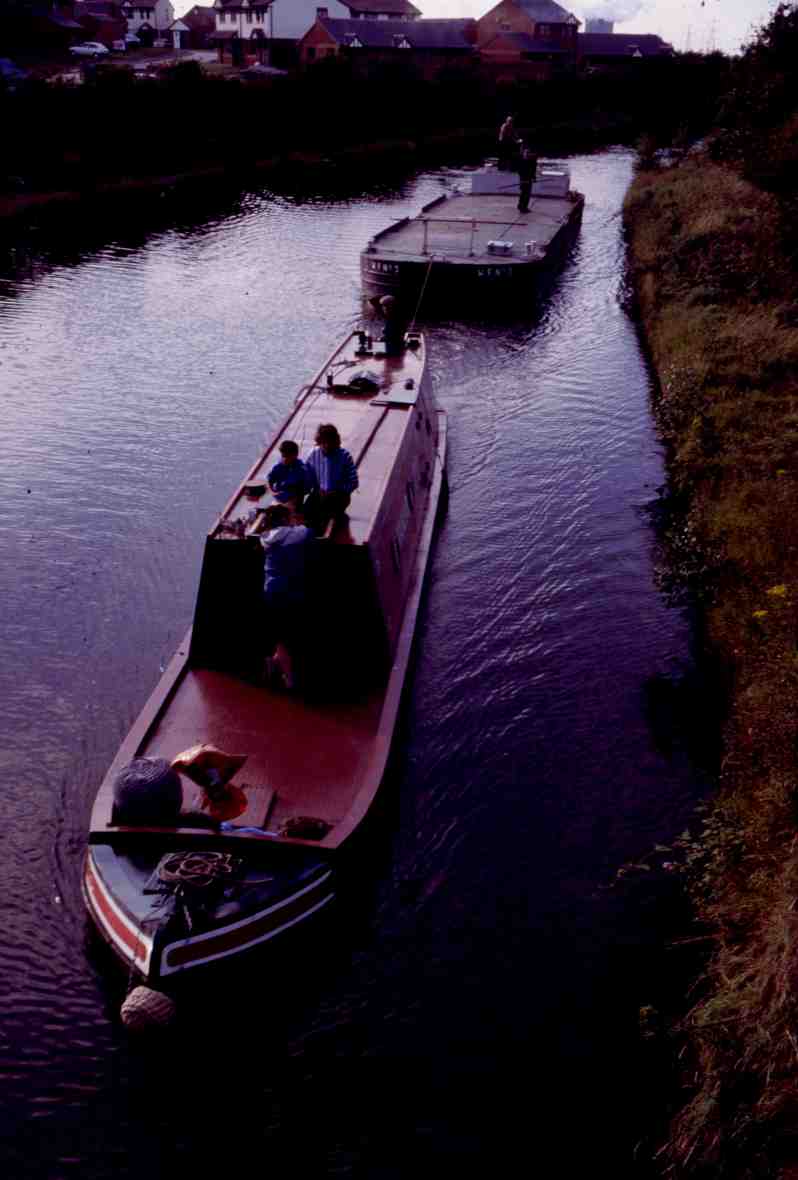
"Tamar" towing "Works Float No 3"
On other weekends during the winter, we went up to the marina, met up with Alec and Dave, and went out in the car. On one occasion, Alec wanted some bits for his boat from Midland Chandlers at Penkridge. After purchasing the required bits, we went to Harecastle Tunnel, which was, at the time, drained for maintenance and removal of the remainder of the towpath.
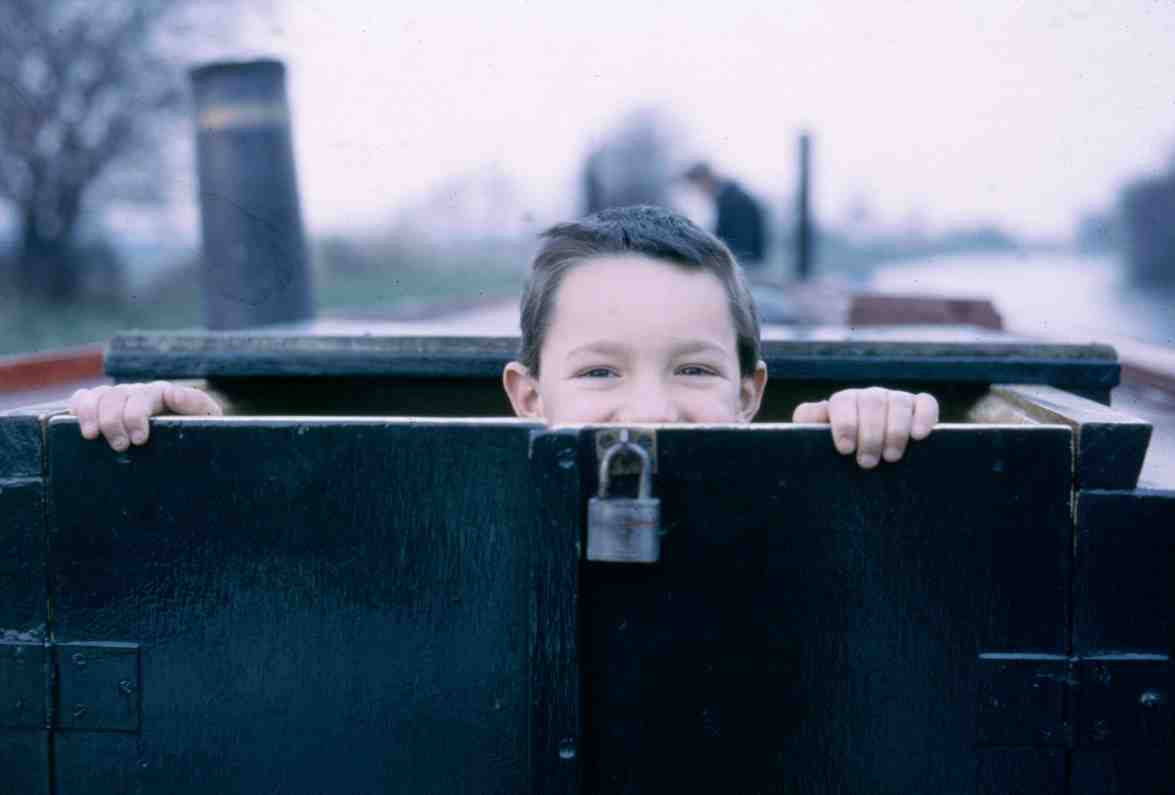
Glyn looking out of "Tamar's" cabin on a cold winter's morning
On another occasion we went to see and photograph the transporter bridge at the Crossfields chemical plant near Walton. The bridge is only one of three remaining bridges of this type in England and spans the tidal River Mersey as it meanders through an industrial area. The bridge is a listed structure and, even though it is situated within the Crossfields chemical complex, it now belongs to Warrington Council, having been bought from the company for the nominal sum of one pound. The other remaining transporter bridges are situated at Middlesbrough spanning the River Tees and at Newport in Gwent spanning the River Usk. The Middlesbrough Bridge is, after the old Runcorn Transporter Bridge, the most famous and was opened in 1911. Even though it was fictitiously dismantled and rebuilt in Arizona for the “Auf Wiedersehen Pet” television series, it is still open for the transportation of vehicles and pedestrians. The Newport Bridge was opened in 1906, is still in use and, as with the Middlesbrough Bridge, is a major tourist attraction.
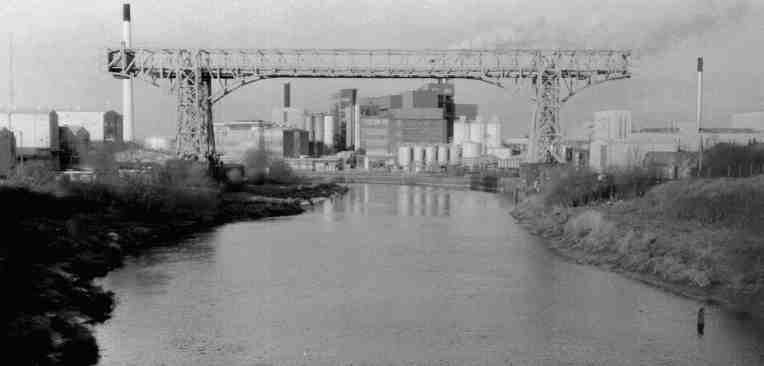
Crossfields Transporter Bridge over the River Mersey near Warrington
With the remedial tasks completed during the winter and spring, “Misty Waters” was re-launched. After the engine was re-fitted, we went on our first cruise of the season to London Bridge at Stockton Heath. At the time I had started working on a long-term photographic project documenting the Bridgewater Canal from one end to the other for an audio/visual presentation. On this particular occasion I took the opportunity to photograph the canal at Stockton Heath after the old Cash's Boatyard and warehouses had been demolished (how glad I was that I did, as a new housing development sprang up soon afterwards totally changing the atmosphere of the area). A canal scene of Stockton Heath was painted on the corrugated iron gates of the boatyard which are now situated at the back of Thorn Marine.
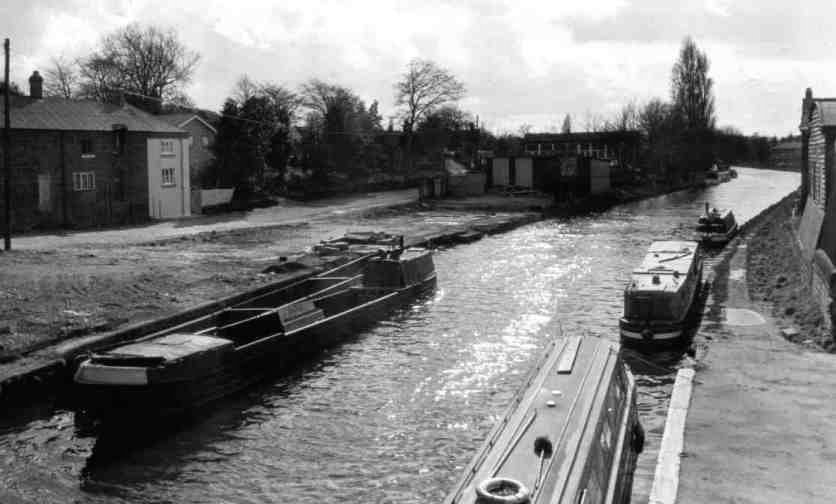
|
The site of Cash's Boatyard at Stockton Heath after being demolished in 1986. |
|
The photograph was taken from London Bridge looking north with Thorn Marine on the right |
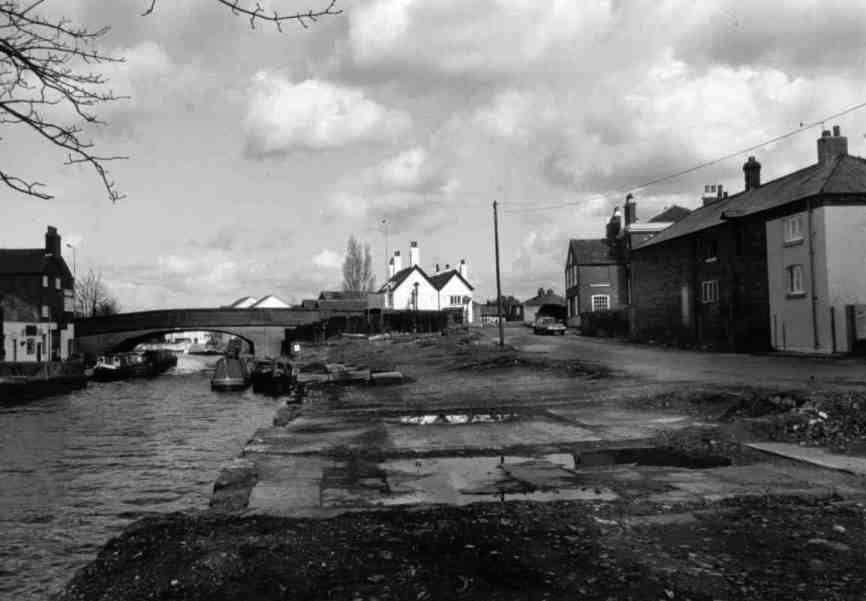
The same location looking south towards London Bridge
At another location that I photographed was not on the Bridgewater Canal but the Leeds and Liverpool Leigh Branch. This was Bickershaw Colliery, adjacent to Plank Lane Lift Bridge and when I photographed it the colliery was still in production (it finally closed in 1992). In years gone by the coal from the colliery was loaded into barges and transported along the canal to Wigan's Westwood Power Station. This trade finished in 1972 but the loading and unloading wharves were still in existence and they were photographed for prosperity.
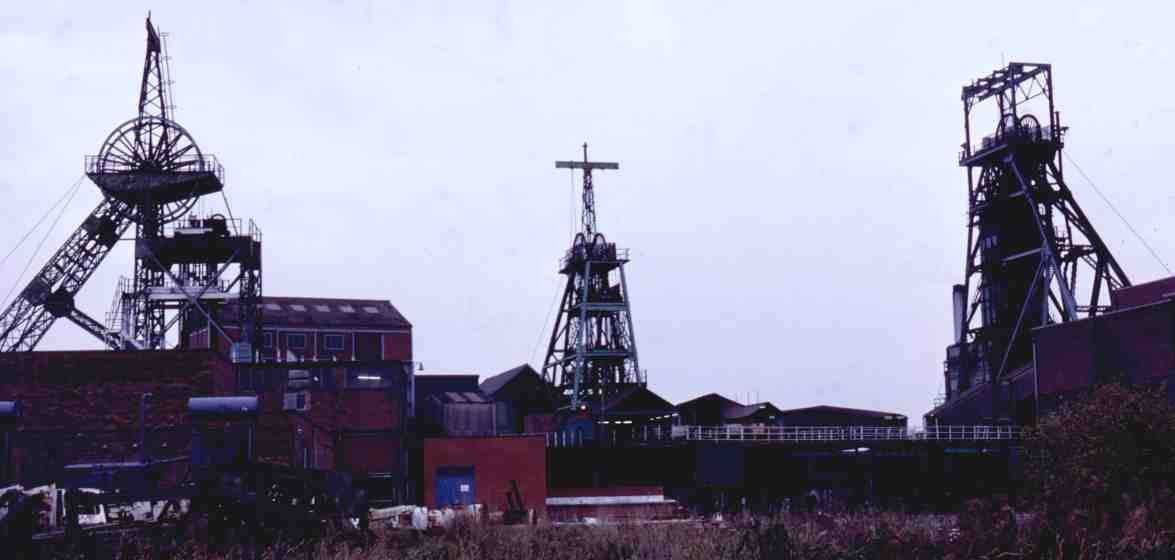
In 1986 the Bickershaw Colliery at Plank Lane was still active but operations were "winding down" (literally)
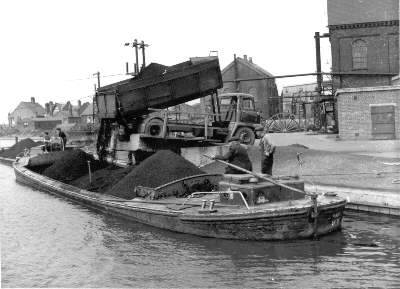
The last coal barge from Bickershaw Colliery in 1972
Wigan's Westwood Power Station in 1986 before demolition
I decided to write a commentary for the presentation and after mixing it with the music and images I decided that I didn’t like it. I continued with the project but became so absorbed that I not only took photographs, but mapped the entire canal and wrote about its history and geography. I called the project “The Bridgewater Book”. I would have liked to have it published but the market for books of this type is extremely competitive with only a handful of publishers interested in this subject, and they have their own “pet” authors with have a proven track record in this subject area. After being refused by several publishers I put the manuscript away in my bookcase for future reference.
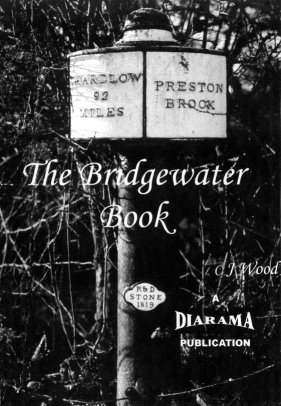
|
The original front cover for "The Bridgewater Book" later to become "The Duke's Cut"... |
|
showing the first Trent and Mersey Canal milepost located on top of Preston Brook Tunnel |
I had fitted a Citizen Band Radio to “Misty Waters” with which to communicate with the other members of our “team” who already had CB’s fitted. In true CB fashion we all had individual call signs or, to use CB parlance, “Handles”. Alec’s “handle” was “Half-Pint” (for obvious reasons), Dave was “Septimus”, Paul was “Albatross”, David and Joyce Stewart were "Tearaways" and I was “Squirrel” (Cyril the Wirral Squirrel). Usually, I was at the head of our little convoy, being the nippiest and most manoeuvrable boat. I relayed information back to the others via the CB radio if a boat was approaching on a blind bend or bridge hole, giving them time to come to a standstill and allow the approaching craft to go past before they proceeded. The system worked well and many “close encounters of the collision kind” were averted in this way.
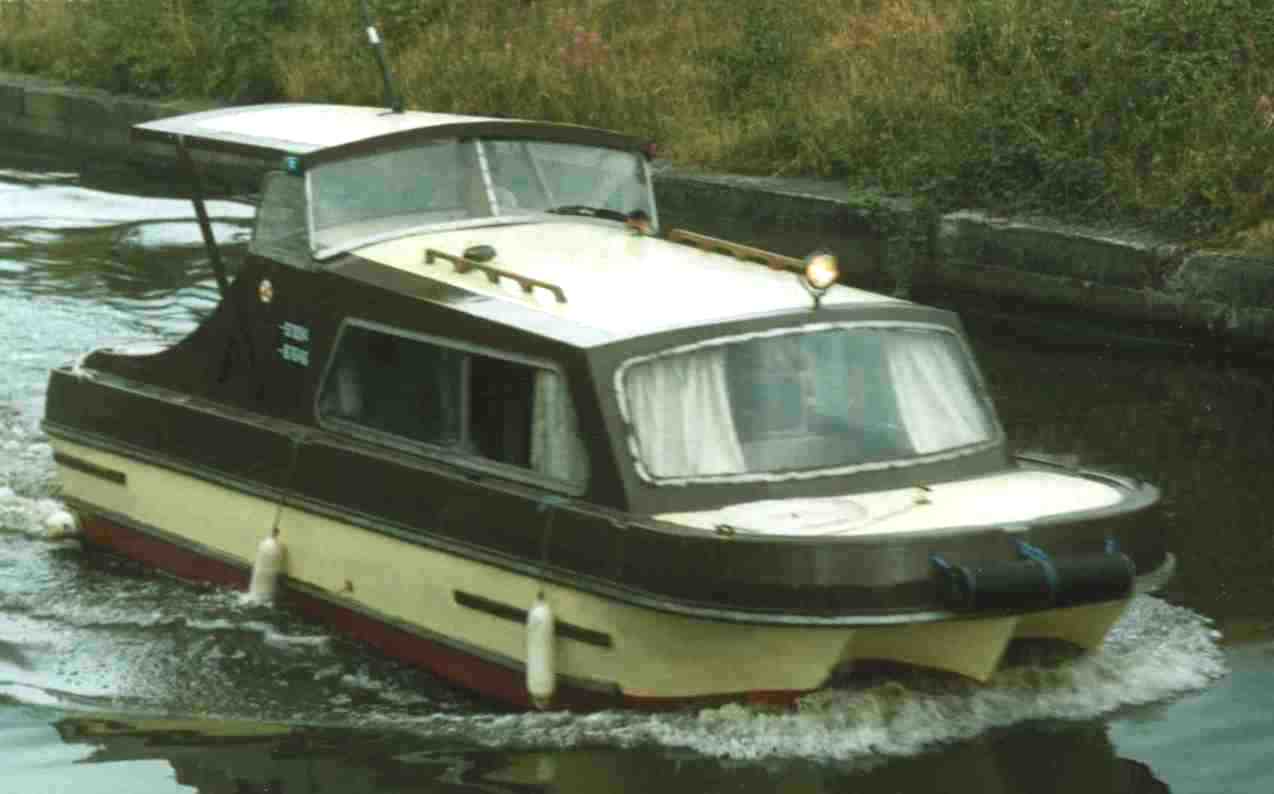
"Misty Waters 2" cruising along the Leigh Branch of the Leeds and Liverpool Canal
We had some new additions to our cruising group… Ann and Ian with a white fibreglass cruiser named “Orca”. They were to accompany us on many of our weekend boating exploits although they didn’t come on holiday with us. They also took a shine to my youngest son, Glyn, who was to steer their boat on many occasions. Another addition to our little group was Norrie… the mad Irishman (“We’re havin’ a party”). Norrie was (and still is) totally mad. One Bank Holiday weekend, we were all going to cruise up to Wigan to inspect the new Wigan Pier complex that had just opened. Norrie was seen loading crates of Guinness onto his boat ready for the trip. So much was loaded onto his boat, “Summer Wine”, a centre-cockpit, steel Dalescraft, that halfway through the trip he had to relocate his ballast as the boat was leaning over to one side due to him having consumed a large quantity of the Guinness. Ray and Thelly from West Kirby also joined us on many occasions. Pat and Pete Bowman with “Ascot Lady” also cruised with us occasionally and have since become life-long friends along with the remaining members of our gang.
The "Old Number One" at Preston Brook in 1987
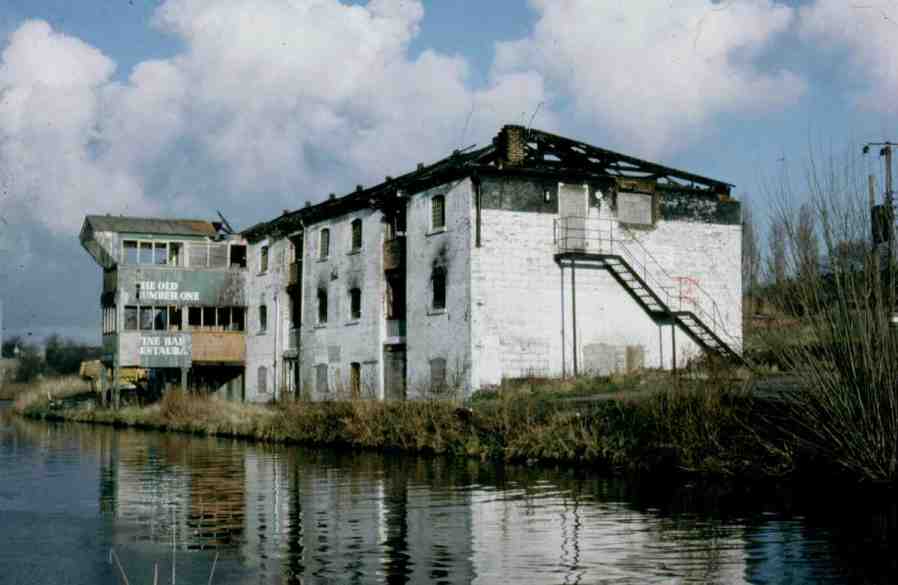
And again but on a warmer day in 1988 (note no sunken boat)
Finally, as it is today, twenty years on from the first photograph, now converted into apartments
For our summer holiday this year (1986) we decided to cruise to the end of the Bridgewater Canal at Leigh and then onto the Leeds and Liverpool Canal. We were accompanied by our friends Alec on Tamar, Dave on Cordelia and Paul on “Rakaia”. Again, we were plagued by wet weather but it didn’t manage to dampen our enthusiasm.
Alec was a company director and needed to be in touch with his office frequently. To solve the problem of communication he installed his cellphone on “Tamar”. I can honestly say that he was the first person I knew that had a mobile phone, albeit a primitive one compared to the compact units that most of us possess today. His Motorola phone was about the size of a house brick (it was really!) and was placed on the top of his boat every day between midday and 1.00 pm. Not only was the phone placed on top of “Tamar’s” cabin but also a large battery the size of another house brick and an antenna about one metre high. It seemed work quite well as he clinched a couple of deals whilst cruising.
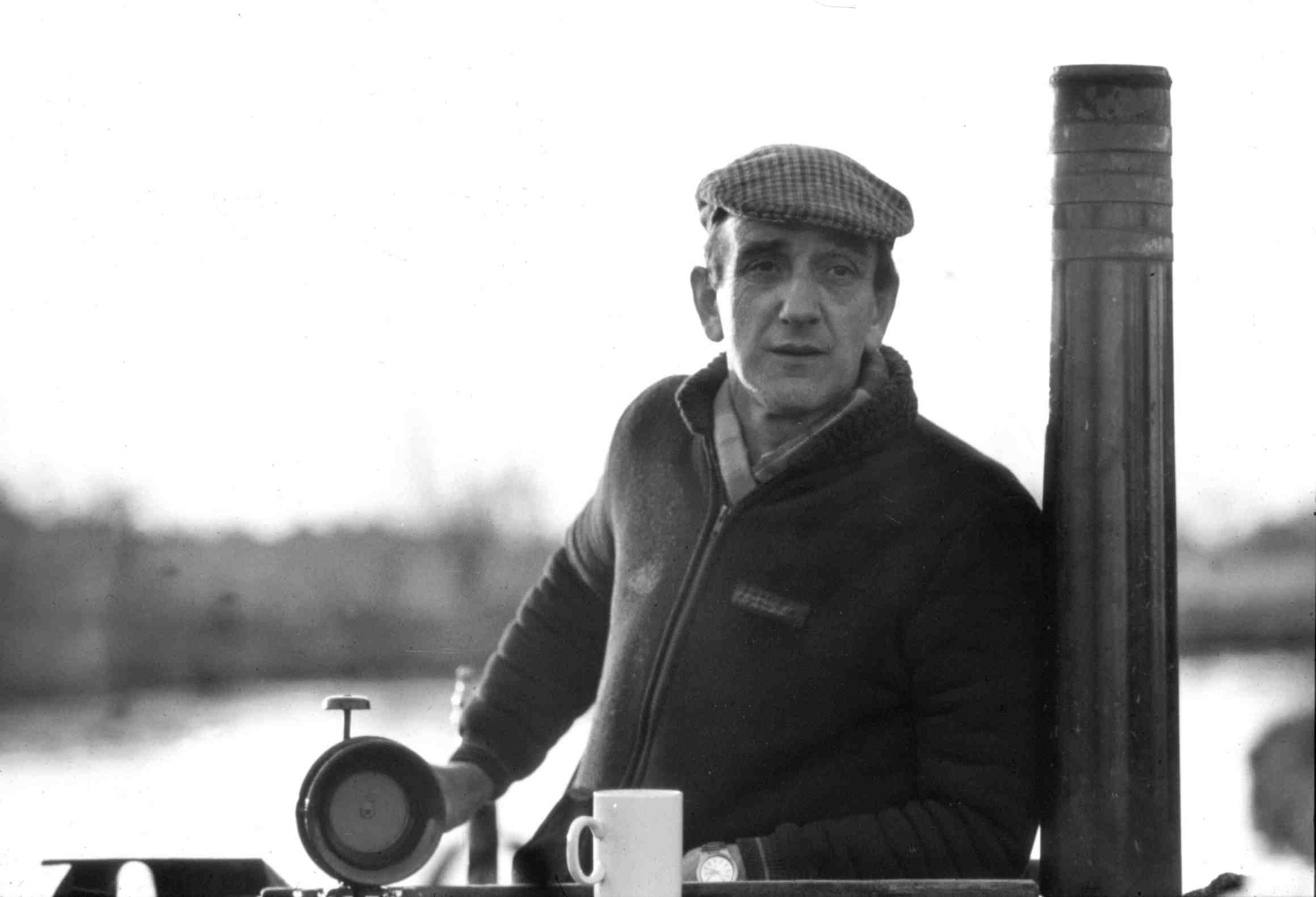
Alec Levac with his cup of coffee at the tiller of "Tamar"
The Leeds and Liverpool is a serious canal by any standards. The locks are broad but a little shorter than normal at sixty feet. Usually constructed of stone quarried further along the canal they possess unusual paddles (cloughs and box paddles as they are locally known - see "Canalscape Book 5 - Chapter 2 - Skipton Excursion"). The flight at Wigan took the best part of half a day to negotiate even though we were helped by British Waterways staff and when we reached the top we stopped for a well-earned lunch. Surprisingly, we were now on a different canal. The Walton Summit Branch is originally part of the Lancaster Canal which was constructed before the Leeds and Liverpool. This stretch of canal was always isolated from the Lancaster Canal proper. There were grand plans for an aqueduct to cross the River Ribble but this never came to fruition. Instead, a tramway (an early type of railway) linked the isolated Walton Summit branch to the Lancaster Canal at Preston via a viaduct and it would have to wait over a hundred years to be connected to the main canal system via the Savick Brook and the Ribble Millennium Link.

Craft moored in Preston Docks at the Ribble Link Protest Rally in 1987
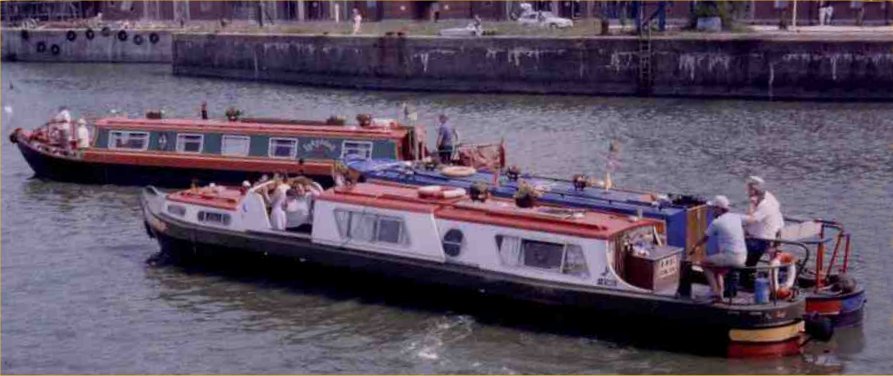
"Painted Lady" and "Ladybird" from BMBC, Runcorn arriving at the rally

Disused warehouses in Blackburn
We cruised through towns such as Blackburn, and Chorley stopping occasionally to take photographs (when the weather allowed). At Burnley we admired the embankment that effectively divides the town into two allowing good rooftop views of the surrounding area. A funny incident happened at the British Waterways yard near Burnley Embankment. We had stopped to empty rubbish, toilets, etc. and to fill up the water tanks. It was raining at the time Alec was filling up his water tank and went to step off the rear deck of “Tamar” to turn off the water tap. As he stepped off he slipped and ended up in the canal up to his waist. He quickly climbed out of the water and looked around (as you do) to see if anyone had seen him slip in. He thought that nobody had and was looking relieved at the fact. The reason he hadn’t seen anyone was that we were all doubled up with laughter and I nearly fell in myself, watching him. Alec has not lived this down and even now we still laugh at this incident.
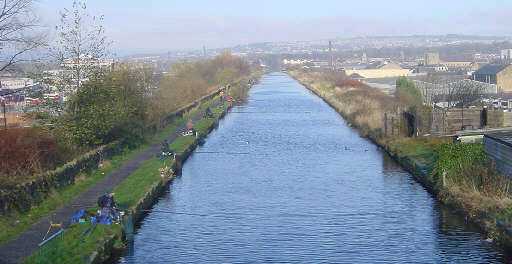
Burnley Embankment - one of the Severn Wonders of the Waterways
After Burnley, we reached the beautiful Dales section which precedes Skipton. We reached Skipton and moored in the Spring’s Branch but the following day we had to turn around and retrace our steps. I would have liked to have reached Bingley and photograph the famous Bingley Five Rise staircase lock but the frequent stoppages caused by the inclement weather meant that we didn’t have sufficient time to journey that far. This is most probably a project for the future.

An unusual "minimalist" footbridge on the Leeds and Liverpool Canal
On our return to our home waters, we met up with Lymm Cruising Club and joined in with their annual barbeque cruise at a location not far from Walton Park known as “Spike Bridge” due to the pipes spanning the canal having anti-vandal spikes on them. On this occasion I met many new friends and was invited to their clubhouse at Lymm to give them an audio/visual presentation when the cruising season had finished. The resulting presentation later that year was most successful and (so I was told) one of the best presentations that they have had of this type. News travels fast on the Bridgewater Canal and I was soon invited to give shows for Watch House and Sale Cruising Clubs.

Steam narrowboat "Monarch" (brother to "President") moored at Preston Brook Tunnel
Whilst on the subject of barbeques, ours were legendary along the Bridgewater Canal (second only to Lymm Cruising Club’s). Alec’s company was a large meat wholesale supplier who supplied meat to the McDonalds restaurant chain and the airline industry to name but two. Consequently, he would usually provide the raw materials for our barbeques. The steaks that he brought were enormous and, to be perfectly honest, I have never tasted steaks like them since. When other craft were passing as the meat was being cooked, the expression of envy on their faces was a picture. Our friends used to join us on these culinary cruises and usually provided the wine or other liquid refreshment (or Guinness if it was Norrie).
The bacon that Alec used to bring for our bacon butties was the finest smoked bacon that money could buy, so you can imagine what it tasted like (provided that you are not a vegetarian). On occasion, he would bring kippers for our Sunday breakfast. Now, I am not a great lover of fish, or anything else that has small bones in it for that matter, but having plucked up the courage to taste these, every other kind of fish paled into insignificance, they were beautiful and guess what… no bones!
The Trent and Mersey Canal clinging to the Weaver Valley side at Dutton
On August Bank Holiday weekend, we all decided to cruise to Middlewich. After a couple of “photography stops” we moored below the Big Lock adjacent to an old lagoon caused by salt mining subsidence. My children… Michael, Lisa and Glyn were exploring and found a grass snake. Michael ignored my warnings that it would spray him with obnoxious smelling fluid, caught it and picked it up. His mother was talking to Alec through the engine room side doors as he cleaned his engine. Michael came up to her with the snake behind his back and said “Look Mum” as he produced the writhing snake. She took one look at the snake, screamed and fell backwards into Alec’s engine room. Fortunately, she was not harmed but insisted that the snake was set free, which it was… but not before it “sprayed” Michael with its obnoxious scent. He was banned from the boat for the next few hours but it was a couple of days before the smell dissipated completely.

Tamar on the Leigh Branch of the Leeds and Liverpool Canal
The season came to an end and we started to make plans for our next year’s holiday. We settled on the “Cheshire Ring” of waterways in an anti-clockwise direction. When the time came we travelled up the Trent and Mersey Canal to Kidsgrove, along the Macclesfield, Peak Forest and Rochdale Canals to Manchester then back along the Bridgewater to Preston Brook.
Part-way through the following season, before our holidays, the Volvo Penta decided to start playing up again. The old problem with the gearbox had reared its ugly head once more, only this time the complete gearbox casing was faulty. The plug fouling had also become worse due to low compression on both cylinders (the chrome liners were damaged). One person who I found most helpful and accommodating with regard to engine repairs was a guy called Rob Hoyle. Rob had a small engine repair and sales business located inside Bernard Hesford’s Boatyard (where we had visited in 1966 when looking for a boat prior to “Phial” being built) at Agden outside Lymm. Rob would give advice and was a useful source of second hand spare parts when new prices from Pilkington’s in Manchester were becoming astronomical. He also told me the best ways of dismantling and replacing parts. I was always amused by the sign on his workshop door that informed customers that “The man who loans out tools has just gone out”!
On meeting Rob for the first time I immediately liked him. He is about the same age as I am, smokes as I did (I gave up in 2004) and has the same (warped) sense of humour as I do… an instant recipe for getting on with someone. Over the years I was to rely on Rob’s advice quite a lot but, much as I liked him I was visiting his workshop too frequently for my liking (nothing personal Rob!).
Acting on Rob’s advice I decided to write-off the Volvo Penta engine and asked Mother if I could borrow the Crescent 18 off “Phial” until I could afford another engine. She said yes and I didn’t have any problems connecting the electrics as the loom layout was identical on both engines. The Crescent was a much more powerful engine than the Volvo and I don’t think that “Misty Waters” had gone so fast in her life as when I first fitted it and tried it out on a deep, wide section of canal on the Runcorn Arm (when there were no witnesses of course). Even “Tamar” had difficulty keeping up when I opened the throttle. But this engine was showing its age as well. After a few weeks the same gearbox problem as the Volvo Penta was manifesting itself and it too was starting to show signs of low compression. Inspection revealed exactly the same problem with the chrome liners as the Volvo Penta. These two problems must be these particular engines’ “Achilles Heels” even though their age was separated by fifteen years. Obviously the manufacturers (originally a German company called Zundapp before the Swedish company – Nymanbolagon of Uppsala, Sweden, took over manufacture. They were, in turn taken over by Volvo Penta who dropped the "Crescent" name) hadn’t bargained for the rigours of Britain’s canal system when designing their engines. The gearbox problems were most probably caused by fishing line, rope and other waterborne rubbish becoming wrapped around the propeller, damaging the gearbox oil seals which allowed water to enter the gearbox and so damage the bearings. The chrome liners corroding could be attributed to condensation forming inside the cylinders when the engines were cooling down after use or when laid-up for the winter. The water resulting from the condensation then attacked the chromium plated bores which then rusted, flaked off and so caused the lack of compression.
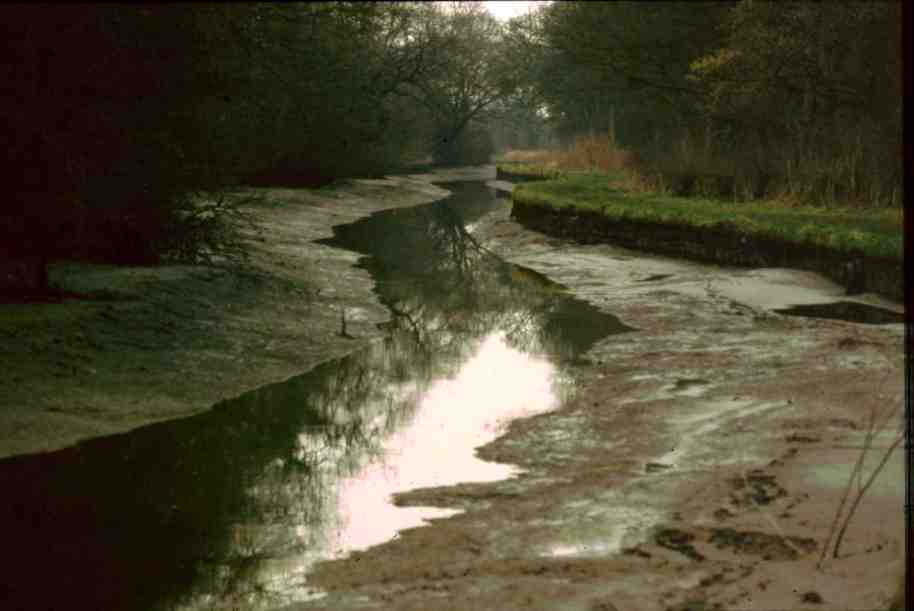
The Trent and Mersey Canal at Dutton drained for repairs to a breach further upstream
A friend of Dave Reed’s had a Volvo Penta 75 for sale. This engine was basically the same as a Honda 7.5 except for minor details, the colour and engine cowling. I bought the engine for, coincidentally, £70 (the same price that I paid for its predecessor which I donated to Rob for spares). Once I had fitted it to “Misty Waters” and was happy with how it ran, I serviced it and fitted the rectifier rescued from the “140” to charge the batteries as well as a remote cut-off and the rudder that Father had made for the Crescent. The Volvo Penta 75 was much more economical than any engine I had used before and was extremely reliable, always starting on the first compression. It was to propel us for the rest of the time that I had “Misty Waters” and I never had any cause to complain about it except for its lack of power when compared to the other Volvo Penta or the Crescent. After installation of the new engine, the Crescent was returned to “Phial” and to the best of my knowledge never ran again.
The blue PVC rear deck canopy had always been a cause for concern on "Misty Waters". When the boat was purchased in 1984 it was tatty even then. I decided to construct a plywood roof for the rear deck similar to other Dawncraft models. At a later date I planned to utilise the redundant PVC cover for side and rear pieces, making the rear deck completely waterproof. The roof section was constructed at the carpentry and joinery workshops at Wirral Metropolitan College's Withens Lane Campus where I worked as a part-time photography lecturer and I transported it up to Preston Brook lashed to the roof of the Lada that I had at the time. Going along the M56 it nearly blew off a couple of times but we reached the marina safely and without incident. It did not take long to fit it to the boat and the finishing touches was fitting the "Super Bazooka" CB antenna with integrated ground plain (necessary with GRP or timber boats) and navigation lights rescued from "Phial". The roof was a revelation as I no longer got wet whilst cruising in the rain. My only worry was that the self-draining outlets were sufficient to accommodate a torrential downpour but my worries were unfounded.
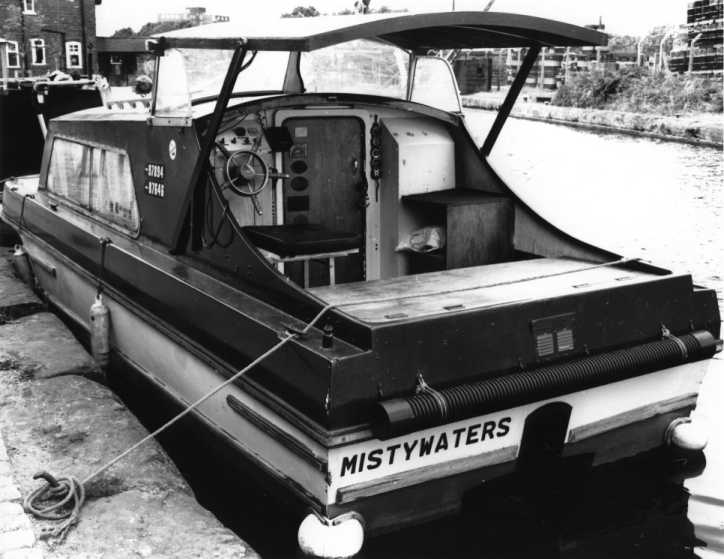
A close-up of "Mistywaters" new roof over the rear deck
The Rochdale Canal near Castlefield at dusk
The following year (1988) was the Inland Waterways National Rally of Boats at Castlefield in Manchester. We planned to spend part of our 1988 holiday at the rally and then cruise on to the Leeds and Liverpool canal to explore below Wigan for the remainder of the time. This was the first National Rally that we had ever attended and enjoyed every minute of it, even, as one expects in Manchester, the weather leaving a bit to be desired at times (leaking clouds).
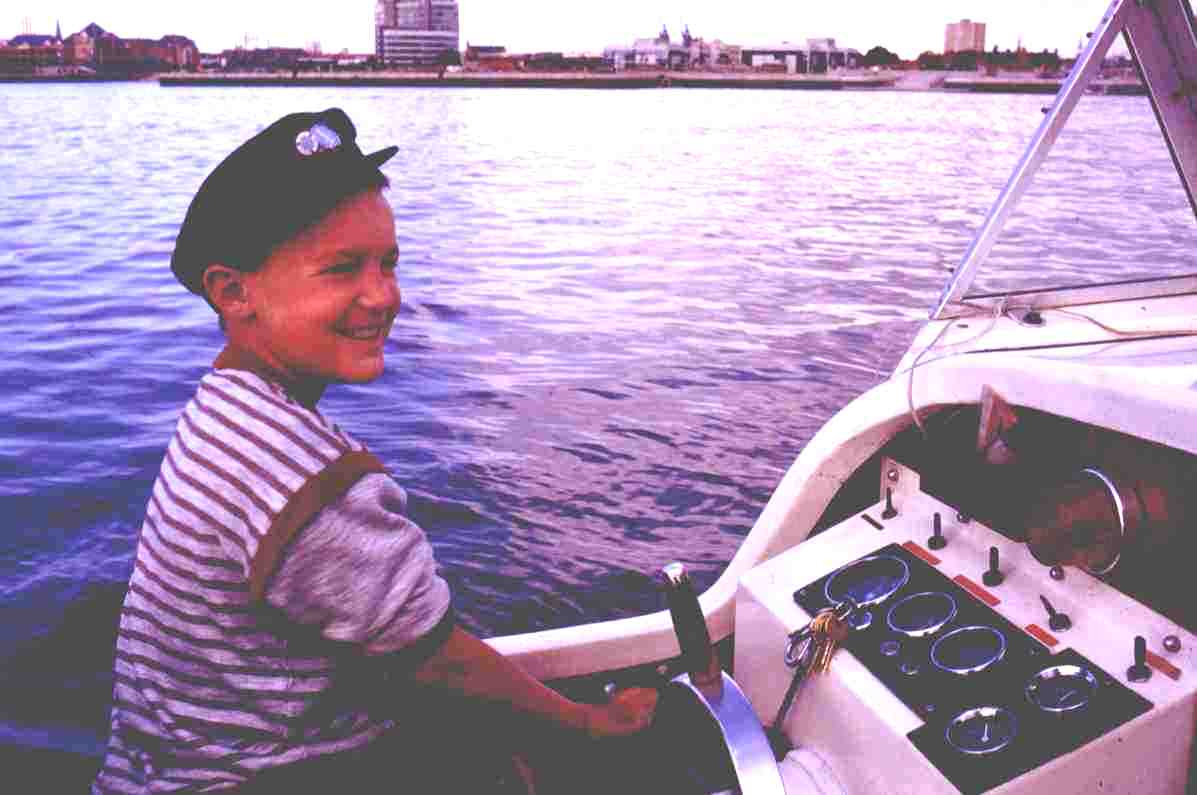
My youngest son... Glyn steering a Nauticus in Manchester Docks

|
"Laura" passes "Barbara Joan" by Trafford Road Bridge in |
|
Manchester Docks at the IWA National Rally in 1988 |
I was eager to cruise and photograph Manchester Docks but, due to craft being moored on the outside of “Misty Waters”, this was impractical. A friend of Alec Levac's offered to take us around the docks on his “Nauticus”. We jumped at the offer, as with someone else driving, it would allow me to take photographs without worrying about steering. Incidentally, when I was taking the photographs my youngest son Glyn was steering the Nauticus after the owner asked him if he wanted a go. It was certainly a rewarding experience. We saw what was to become Salford Quays whilst being constructed as well as what must have been one of the last large merchant ships to reach Manchester and the various canalside locations before redevelopment. Our cruise through Manchester Docks was over all too soon but boy was I glad that I took those photographs (see “Canalscape Book 3” - Chapter 2 - "Total Eclipse").
Wigan Pier at night
We left the rally when it was finished and cruised up to Wigan, taking our time and I managed to photograph many parts of the canal that I had previously not been able to capture on film, usually because of bad weather. We spent some time in Wigan before carrying on down the canal towards Liverpool. We were surprised at the beauty of some of the sections below Wigan, especially the section between Dean Locks and Parbold. The canal runs in the River Douglas Valley and is quite isolated.

Sunset on the Leeds and Liverpool Canal at Apperley Bridge
The locks at Appley Bridge are also quite picturesque, where the canal splits into a dual carriageway at different levels. I was so impressed with this stretch of canal that I wrote an article entitled “Is There Life Below Wigan?” which was published in “Waterways World” in the October 1991 edition (see Chapter 5 - Is There Life Below Wigan?).
Dave on “Cordelia” had to return to work after the rally and did not accompany us on this part of the holiday. Alec also had to be back at work before I did, so he left for the marina at Preston Brook whilst I stayed at Dunham Massey at the Lymm end of the canal, again exploring in detail and taking photographs seeing as the weather had cleared up.
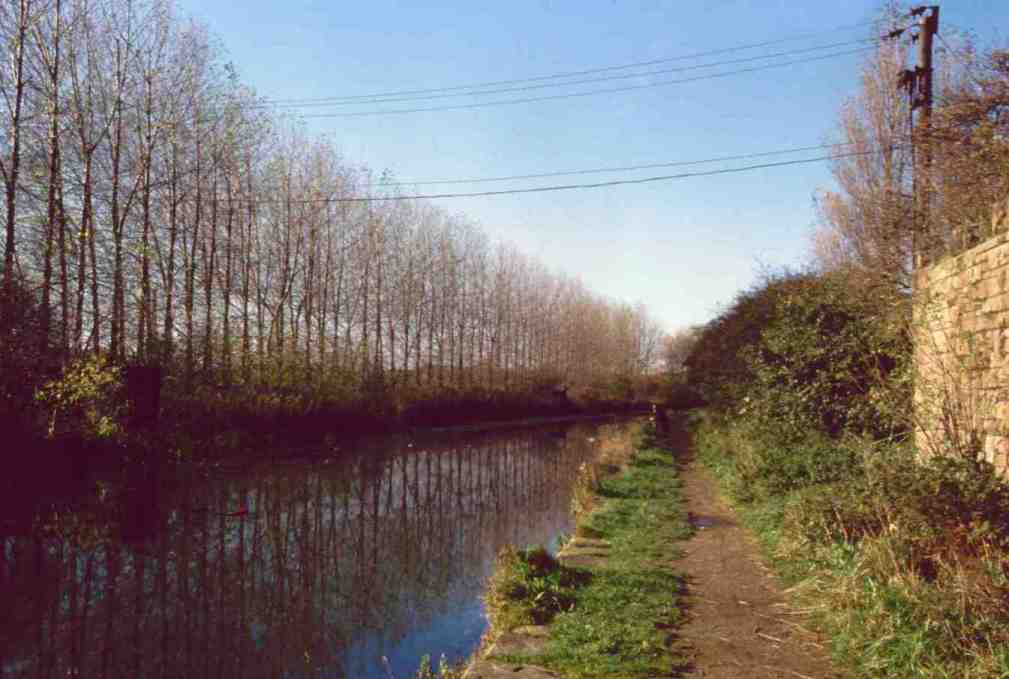
An unusual line of Poplar trees on the Leeds and Liverpool Canal at Old Roan near Aintree
During my times with “Misty Waters”, we attended many boat rallies throughout the whole length of the Bridgewater Canal. My children and I always had a good time at these rallies, joining in the activities, making new friends, etc. On one occasion, we attended the Federation of Bridgewater Cruising Clubs annual rally, which, this particular year (1989) was held at Watchouse Cruising Club near Stretford. My children made friends with the children on “Desiderata”, a narrowboat whose owner was Graham Ridge, a member of the Bridgewater Motor Boat Club based at Runcorn. Their son had a small wooden dinghy and invited my children to join him paddling around. One of the children had the bright idea of charging people ten pence to ferry them across the canal, and they took turns in paddling, sharing the takings out later on for sweets, etc. All went well until a well-built lady, who had been ferried across was getting out of the boat and fell in. I can still see the look of horror on the children’s faces as her wig came off and it started to sink to the bottom of the canal!
Another happening, unbeknown to me, that involved “Desiderata’s” dinghy, was that the children were towed through Preston Brook Tunnel in the dinghy behind Norrie on “Summer Wine”. I only discovered this recently when my youngest son Glyn confessed the tale to me. To say that I wasn’t impressed would be an understatement.
My daughter... Lisa relaxing on "Tamar's" front deck
1989 was also the year of the Trent and Mersey Canal Society’s rally at Anderton to promote the lift’s restoration. This was a wonderful rally. The Mikron Theatre Company was there and the entertainment was brilliant. There was something for everyone. We made more new friends as well as supporting the reason for holding the rally at this location… this was to focus attention on the disrepair of the Anderton Boat Lift. Hopefully, British Waterways would get their act together and make some positive progress on the restoration work. It is a good job that we didn’t hold our breath waiting for some action as it was to be thirteen years for the restoration to be completed and the lift open for business again.
After the rally, we carried on along the Trent and Mersey Canal to Middlewich and onto the “Shroppie” heading for the Boat Museum at Ellesmere Port. The highlight of this part of the trip was whilst we were at the Museum (which is about fifteen miles from our home in Wallasey). A group of visitors from Glyn’s school visited the Museum, (I obtained permission for the children to take a week out of school for the first part of the holiday as it was the last week of term) and I will never forget the look of pride on Glyn’s face as he showed his class mates over “Misty Waters” and our friend’s boats. At one time I think that we had ten children on “Misty Waters”, most probably not a record but it seemed a lot at the time.
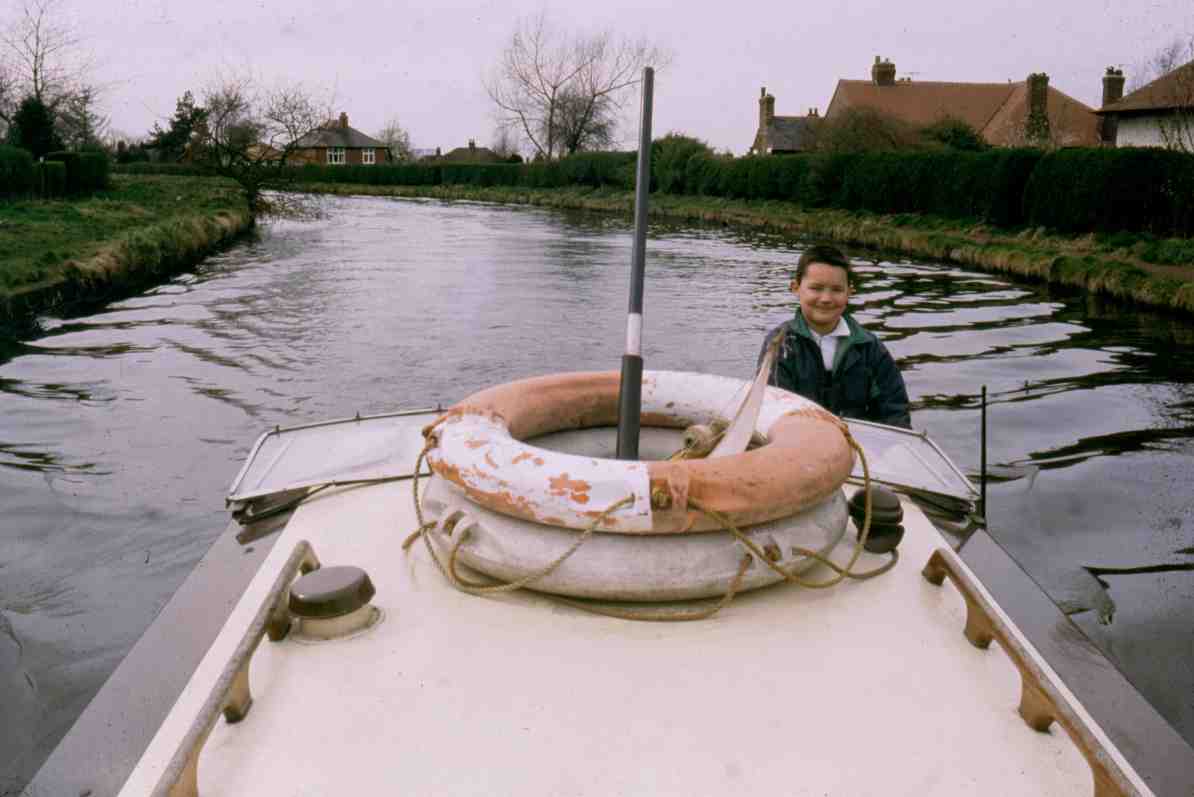
Glyn steering "Mist Waters 2" on the Bridgewater Canal at Grappenhall in 1987
On the return trip we stopped at Beeston and spent some time there and introduced our friends to Mother and “Phial”. Dave Reed on “Cordelia” could not join us due to pressure of work. After climbing out of the River Gowy Valley we cruised to Nantwich and on to Audlem where we moored below the flight of locks, visiting the village and lock flight by foot. This was quite a relaxed holiday and it was good to revisit so many old haunts but, unbeknown to us; it was to be our last holiday on board “Misty Waters”.
A recent photograph of the Boat Museum at Ellesmere Port
The remainder of the season was a good one. We cruised virtually every weekend, even when the weather was unsuitable. We were invited to join in Lymm Cruising Club’s barbeque at “Spike Bridge” between Walton and Moore. As usual, Lymm made us most welcome. They plied us with food, wine and canal gossip and we had a most enjoyable evening. But there were storm clouds looming on the horizon and my future was soon to be changed for ever.

Lymm Village on the Bridgewater Canal
Chapter 3 -
Dark
Days
I have called this chapter “Dark Days” and it is a period that I will not dwell on as this is meant to be a light-hearted text, not a depressing one.
I had suspected for a long time that my wife was having an affair. I will not stoop to naming and shaming the guilty party but he knows who he is. All I will say is that he keeps his boat on Preston Brook Marina quite close to where "Misty Waters" was moored. I decided not to do anything about the affair until I thought that my children were old enough to handle the situation emotionally. I waited until the following year (1990) when Glyn was twelve until I started divorce proceedings.
On one occasion the guilty party was bending down on one of the marina’s mooring piers, inspecting the exhaust on his boat and I just could not resist the temptation to push him in. I must admit that it felt good but I did apologize (half-heartedly) later on for my childish behavior (put it down to revenge… a dish best served cold, just like the marina’s water).
Due to the ensuing financial pressures brought on by the divorce, “Misty Waters” had to be sold early in 1990, just prior to my Mother’s death. During this time I was extremely unhappy and it seemed as if my life was going through a period of great change. My marriage had come to an end, my canal cruising activities had finished and remaining parent had died. I was also a single parent looking after three children with minimal input or support from my ex-wife, plus I had been left with a pile of debts after the marriage had ended that I had believed settled or not known about.
It was as if there was something missing in my life (besides love and money), which seemed to be lacking direction both from a personal point of view and from a waterways point of view (except for my photography trips and audio/visual presentations).
Frodsham Viaduct carries a railway track over marshlands, the Weaver Navigation and the River Weaver
I regularly showed my audio/visual presentations to various interested societies and sometimes traveled quite a distance to put them on. I remember being asked by the Birmingham Canal Navigation Society to put on a show for them and traveled to Dudley one evening in order to reach the venue where they held their meetings. I showed them "The Duke's Cut" presentation and I do not think that they were very impressed as they did not know the Bridgewater Canal on which the presentation was about. They didn't say very much at the end of the evening and I was not invited back! In the autumn of 1990, completely out of the blue, I was asked to put on an audio/visual presentation for Runcorn’s BMBC (Bridgewater Motor Boat Club). The show was a great success and there was a visitor in the audience who was one of Lymm CC’s committee members. After the presentation, the visitor approached me and asked me if I would be interested in putting on a presentation for Lymm CC in the not too distant future. I agreed to put on a show for them later on in the year. The presentations that I showed Lymm CC were “The Duke’s Cut” and “Canalscape”. The evening was an overwhelming success and even today members still remember the evening with fondness.
As previously mentioned, in the October 1991 edition of "Waterways World" I had an article published entitled "Is There Life Below Wigan?" (see Chapter Five - Is There Life Below Wigan?) The publication of my work in the premier waterways magazine was a big boost to my ego which was badly needed at the time. The article is supplemented by a follow-on article... "Is There Still Life Below Wigan?" in "Canalscape Book 4" which documents a more recent cruise along the canal as well as the new Liverpool Link.
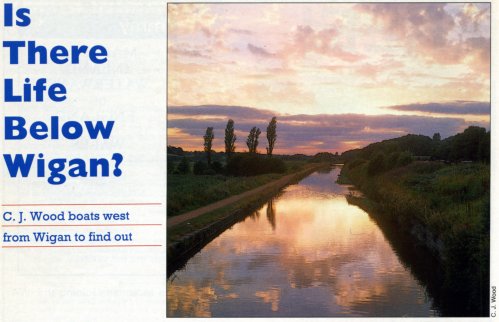
The header of the "Waterways World" article
More presentations followed as my reputation for audio/visual presentations became more widely known. I traveled further up the Bridgewater Canal to Sale Cruising Club, and Watch House Cruising Club at Stretford. On one occasion I even put on a presentation for the Birmingham Canal Navigation Society on their home ground in Dudley!
I kept in touch with my canal cruising friends, regularly bumping into them unexpectedly when going out for the day in the car to Llangollen or Manchester or some of the other canal locations that we regularly visited. On one occasion I was taking photographs at Audlem on the “Shroppie” when I was approached by a complete stranger who engaged me in conversation. He enquired about the equipment that I was using (a Rollieflex 3.5 E and an Alpa 5B) and what I did with my photographs. I explained about my audio/visual presentations and the next thing I knew was that I was agreeing to put on a presentation for the photographic society in Whitchurch that that he was a member. The subsequent presentation suffered one of the few equipment break-downs that I have experienced. The four track cassette deck chewed a tape but, after a short unscheduled intermission, I managed to salvage it and re-synchronize the presentation without too much disruption. Bearing in mind the problem encountered the remainder of the evening turned out to be a great success.
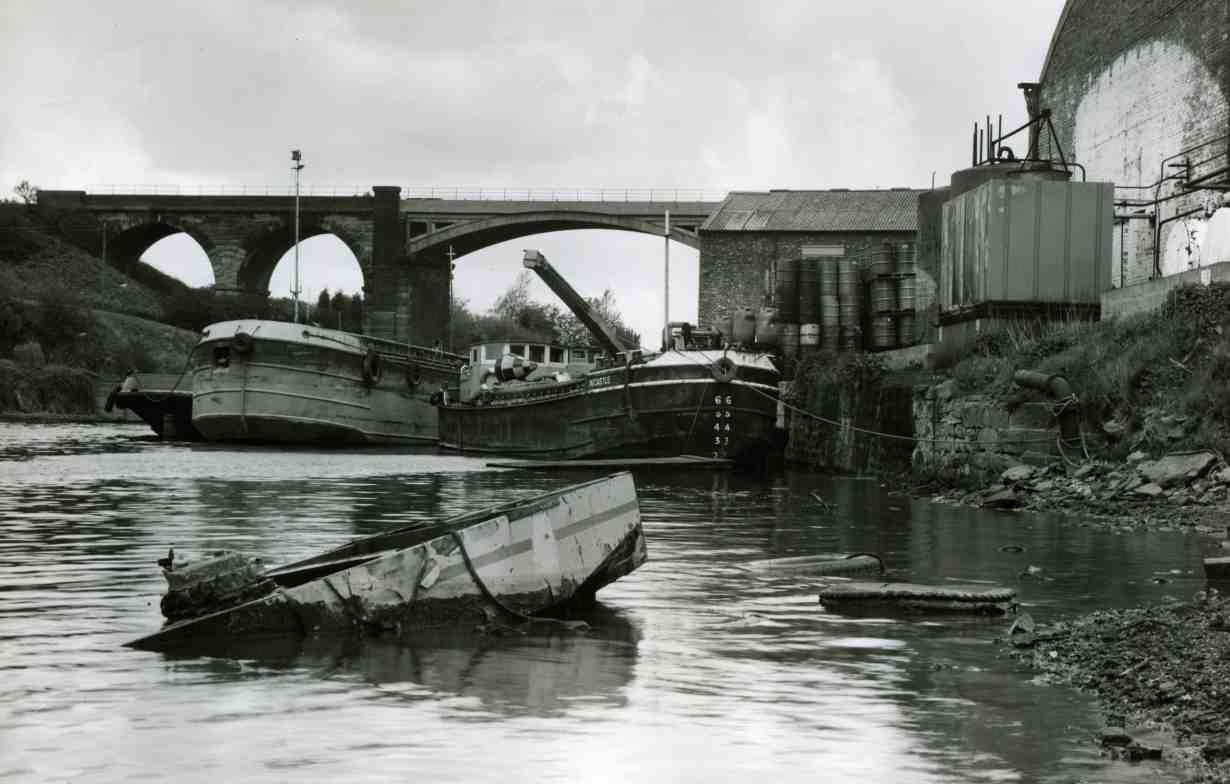
Another photograph of Frodsham Viaduct and the River Weaver taken from below Frodsham Bridge looking downstream
At the time, I was employed by Wirral Metropolitan College as a lecturer in photography (who I am still employed by) and on many occasions I took students out for photographic field trips to various locations. As you might suspect, sometimes these locations would have connections with canals and inland waterways and as well as the students producing photographic images to be proud of they were introduced to the private, secluded world of canals and inland waterways. Some of the places that I took students to were the mighty Pontcysyllte Aqueduct, various locations along the Manchester Ship, Bridgewater and Shropshire Union Canals as well as inviting them on occasions to my Audio/Visual presentations.

The draining of Boothstown Pen, captured on a field trip with college students
On one occasion I filled the two hundred and fifty seat “Rake Theatre” within Wirral Metropolitan College’s Withens Lane Campus with, not only students, family and friends but also canal and photography enthusiasts. I projected images onto a screen twenty five feet across and filled the theatre with beautiful music that accompanies the presentations from my giant Jamo loudspeakers. There were many requests from the audience to “turn up” the music and the theatre reverberated to the soundtrack of the presentations. It’s a good job that there were no houses nearby as there would surely have been complaints from the neighbours! This was one of my most successful presentations, possibly because it was just that... an audio/visual evening with friends and colleagues and not tagged onto a club or society meeting where time was a problem. The closeness to home was a bonus and I did not have to travel many miles to reach the venue which gave me extra time to set-up the equipment to my satisfaction.
I have unconsciously introduced many people to the tranquility and beauty of a hidden world along the towpath that they didn’t know existed and, even now ex-students that I meet remember the good times that we had on those trips. My good friend and fellow photographer Steve Jones accompanied me on some photographic excursions, one of which was to the derelict Manchester, Bolton and Bury Canal at Prestolees when we captured the Prestolees Aqueduct. This canal is slumbering and awaiting restoration. At that time it was unlikely that this restoration would ever take place.

Prestolees Aqueduct, photographed fifteen years prior to the announcement that the canal would be restored
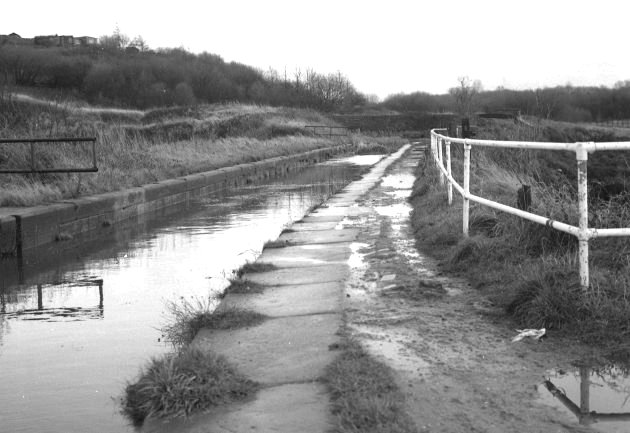
Even then parts of the canal was still in water and looked "cruisable"
As previously mentioned, my life lacked direction and whenever I saw a boat cruising along a canal I longed for the time when I would be able to cruise along by beloved canals and inland waterways once more. The turning point that signaled the end of the “Dark Days” was the relationship that I had with my next-door neighbour… Ange. She was also recently divorced and we were already good friends, helping each other through our respective divorces. As time went by we grew closer, started dating, became engaged and planned to be married as soon as circumstances and finances would allow.
A frozen Trent and Mersey Canal at Dutton in winter
In the autumn of 1993, I was asked to put on a presentation entitled "The Mersey Ring" for Runcorn’s BMBC. Ange accompanied me as did my youngest son Glyn and Ange's son Michael. This presentation turned out to be quite a marathon... the first transparency went onto the screen at 7.30 and, after a couple of intermissions (for the audience as well as myself and the equipment) the show finished at midnight. It was on this occasion that Pat and Roy Wilcox (two of my old canal cruising friends and also committee members of BMBC) asked us if we would like to borrow their Frobisher narrowboat… “Painted Lady”, for a long weekend cruise. We accepted and spent an extremely enjoyable (if not cold) few days in February of the following year cruising along the Bridgewater and Trent and Mersey Canals as far as Billinge Green Flat where the thickness of the ice forced us to turn around and head back to Runcorn. During the trip my youngest son Glyn and Ange’s son Michael took turns steering. For Glyn it was good to be traveling along the canals again and Michael enjoyed it as well. We didn’t see many other boats out cruising which, I suppose, is not surprising considering the weather and the water conditions.
The author aboard "Painted Lady" on an icy February morning in 1994
(Photograph by Angela Wood)
Author’s Note...
There is an overlapping of dates in this chapter and “Phial Again”… the next chapter. Chronologically speaking, “Phial Again” actually starts three quarters of the way through “Dark Days” but I have separated these two chapters for the sake of clarity and if the lack of continuity in the dates confuses and detracts from your enjoyment… I apologize.
Chapter 4 -
“Phial”
Again
With having so many friends and fond memories at Beeston, quite often, when out for a drive, we would find ourselves sitting on the balance beams of Beeston Iron Lock’s gates, visiting friends, remembering the happy times spent there and, not forgetting the oldest friend of them all… “Phial”. It was on such a visit during the summer of 1991 that we were shocked to discover “Phial” had been painted blue and white. The lovely honey coloured varnish had white and dark blue gloss slapped all over it, and what was worse, she looked dirty, tatty, unloved and unused.
In late July 1992, on an evening drive to Beeston, we discovered a “for sale” sign in one of “Phial’s” windows. My youngest son, Glyn, ventured over to “Phial” and wrote down the telephone number on the sign. In the forty minutes it took to drive home, my children suggested that I bought “Phial”, cleared out our back yard, knocked down the back wall, arranged transportation for the boat and deposited her in the back yard. Once “Phial” was safely deposited in the back yard I could spend the next few years returning her to her former glory. I had to agree with them that the suggestion was a good one, and not only that, it stimulated my imagination. I had visions of restoring the boat, buying a cheap four wheel drive vehicle, a trailer for “Phial” and visiting the Irish waterway network as well as some of the more isolated English, Welsh and Scottish waterways not connected to the main waterways system.

"Phial" painted white
I rang the telephone number the following day and spoke to the owner, a Mister Ellis. I then made an offer of £500 for “Phial” which was accepted, but when I told the owner that my parents were the original owners of the boat, the price was lowered to £450. A week later, he dropped the keys in to me and the following day I went alone (purposely) to have a look inside. Accordingly, I traveled up to Beeston on my Honda motorcycle. When I arrived at Beeston and went inside “Phial” I was not prepared for what greeted me. The white paint was not confined to the outside of the boat. The varnish inside had also been daubed unsympathetically and mercilessly with the same white gloss paint as the exterior. A “sun roof” had been added, roof timbers replaced (none too expertly) and the whole of the gunwales had been sealed with dark blue fibreglass resin. Many other modifications had been made and the only one that I agreed with was the fitting of an electric fresh water pump and even the wiring for that was dodgy. Attempts had been made at re-wiring with cables dangling down from the ceiling. I sat down and I sobbed. I even talked to the boat, promising to restore her back to her former glory. It must sound stupid getting emotional about a boat, but when you can remember the boat as it was when it was new, remember the work that my father had put into it and have spent as many happy hours on board, then see it as it was at this point in time, it is sad to see what inexperienced hands are capable of.
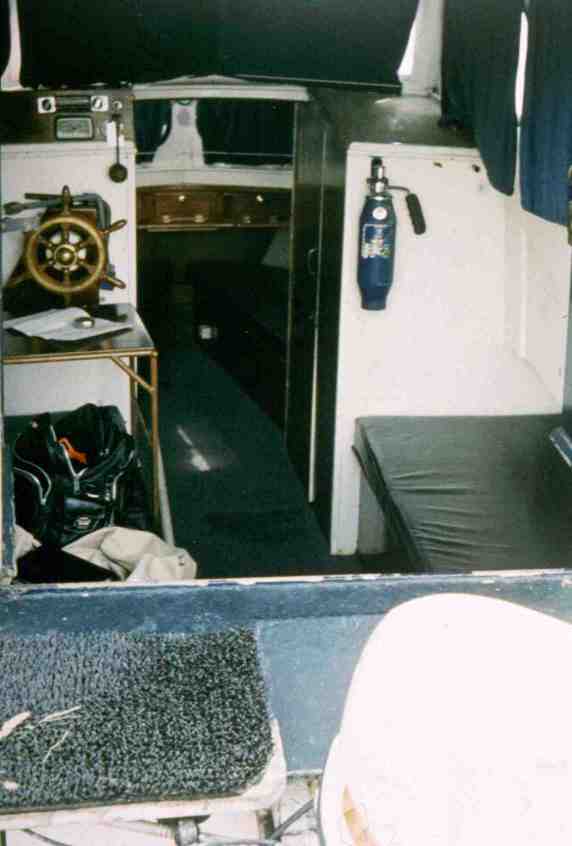
"Phial's" interior, also painted white
On my return home, my plans started to be formulated. The B.W. Boat Standards were consulted. The only major modifications needed were the re-location of the gas bottles, fuel tank and batteries. The former two items would be located in “panniers” that I planned to make out of fibre glass and attach to the transom either side of the outboard motor, matching the hull profile.
On August 16th 1992, I paid Mister Ellis the £450 asking price and “Phial” was once more back in the family.
The following week, the Crescent Marin 18 outboard motor was brought home and stored along with the bunk cushions that were now covered in horrible blue PVC instead of the previous deep red velour. Some of the rubbish left behind by Mister Ellis and his family was also removed. In the meantime, back home, the back yard was cleared and covered in PVC sheeting. Permission was obtained to cross the land behind the house and the back wall was knocked down.
I had to find somebody with a boat trailer and a vehicle powerful enough to pull it whilst loaded with a boat that weighed the best part of two tons. That Saturday evening I drove up to Moore near Daresbury to see if my old Bridgewater Canal friends Dave Reed or Alec Levac were having a drink in the Red Lion. I drove over the hump-backed bridge and looked to see if their boats were moored adjacent to the “Tramp’s Grave” (see “The Duke’s Cut” published by Tempus) and was pleased to see both of their boats there. I drove around the bend to the pub and found them in their usual corner. I explained about buying “Phial” and the need for a trailer. Dave gave me the telephone number of Phil from C. P. Marine at Preston Brook Marina who did boat transporting professionally. After a quick chat I bade my old friends farewell and promised to let them know how I got on.

"Phial" being slipped onto the trailer at Beeston
(Photograph - David Michelson)
The following day I rang the number that Dave gave me and made arrangements to transport “Phial” to Wallasey on 5th September by Phil from C. P. Marine. The plan was to slip “Phial” onto a trailer at the slipway below Beeston Iron Lock where “Misty Waters” was once moored. I borrowed the College minibus and took my children plus some friends to help with the operation. One of the people accompanying us was David Michelson... one of my students who documented the occasion photographically. Dave's son... Wayne Michelson is a photographer for a magazine specializing in Land Rovers and a Land Rover enthusiast himself. On our arrival at Beeston someone had parked a car across the entrance to the slipway, so an alternative site was found above the lock adjacent to “Phial’s” mooring where she was slipped out ten years earlier in 1982 to have the leaking keel bolt replaced. Eventually, she came out of the water and was lashed to the trailer before being towed to Wallasey behind Phil’s V8 engined Range Rover. Halfway through pulling “Phial” out of the water, my brother Jim arrived. Not having seen the boat for some years, he felt as I did and I could see tears in his eyes.
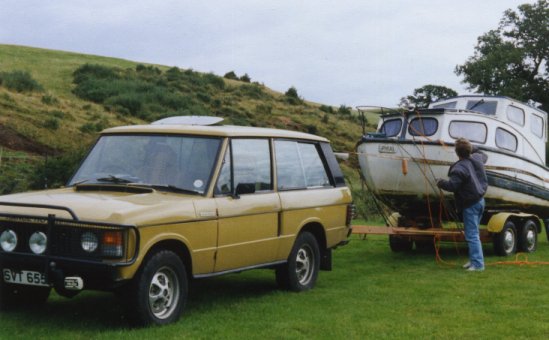
Phil checking the securing straps before departing Beeston on the journey home
(Photograph - David Mitchelson)
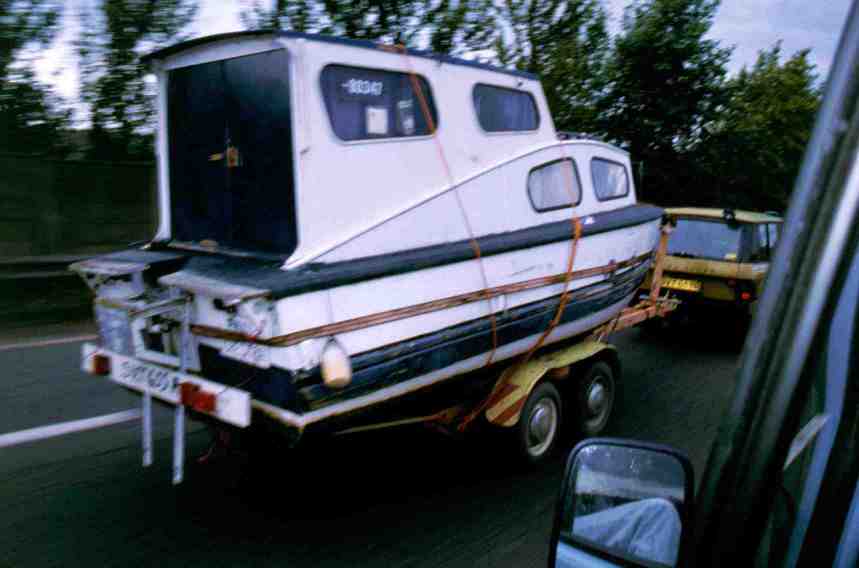
"Phial" in transit to Wallasey
(Photograph - David Michelson)
Once “Phial” reached the land at the back of my house, the trailer was reversed into position and "Phial" slipped off onto rollers, over the foundations of the demolished wall and securely chocked into position on top of the thick PVC sheeting that I had laid in my back yard. After being paid, Phil then left us to our own devices. Cleaning and stripping started almost immediately. On lifting the floorboards, water was found in the bilge, but I suspected (correctly as I later discovered) that this was rainwater that had seeped in through an unsealed joint and via a rotten piece of timber at the back of the rear cabin.
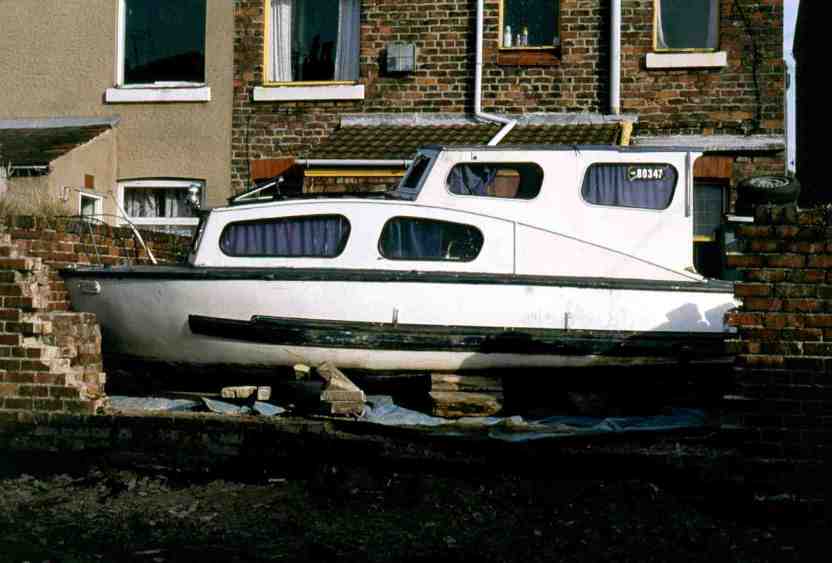
Not many houses can boast a classic 1960's canal cruiser in their back yard
The only damage sustained in transit from Beeston was to a thin piece of beading was removed on the joint between the rear cabin roof and sides. It had been glued into place with “Polyfilla” (yes… “Polyfilla”). Its accidental removal wasn’t a problem as I had planned to replace it anyway.
Jim had followed us home, and after all our helpers had left, I asked him if he thought that Mum and Dad would have approved of what I’d done in bringing “Phial” home for restoration. He looked at me and, with another tear in his eye, said that they would have definitely approved.
Now that the transportation was completed, the hard job of restoration could commence. The moss on hull was cleaned off and the interior of the boat stripped of all fittings in preparation for the removal of the white gloss paint covering the originally varnished interior. Most of the previous owner’s additions were removed and ended up in the bin. “Phial” was then “put to bed” being covered in her original, tailor-made tarpaulin cover to prevent any rainwater seeping in and help her dry out until the spring. Over the winter months I started to document the boat's history and my labours. The resulting work was entitled "The Phial Story" and with hindsight I can say that it was the foundation stones of what was to become the written version of "Canalscape"
I needed some advice concerning certain aspects of the woodwork, replacing certain parts and caulking joints so one Saturday I took a trip to J.H.Taylor's boatyard in Chester to pick David Jones' brain. When I arrived he was at lunch so I had a look around whilst I waited. Imagine my surprise when I came across a Marlin hull, stripped of its superstructure tucked away in a corner of the yard. It was useful to see as it gave indications as to how certain details of construction were handled. When David came back from his lunch we had a long chat about boat restoration and Marlins in particular. He even had some of the glass fibre matting and epoxy resin that was originally used by Marlin Craft in the laying down of their hulls and he donated it to me.
Over the following months, timbers were replaced, the interior was re-varnished, the electrical system was re-wired and new lights fitted, the water pipes replaced, the original flushing toilet had already been removed but the outlet pipe was still fitted. This was removed, the aperture glassed and a new “Portapotti” toilet installed in its place. After the winter months had passed, attention focused on the exterior. The “sun roof” was removed and replaced by a solid piece of marine ply; the gunwales were removed and re-timbered along with other suspect timbers.
|
|
|
|
Timber in various places needed replacing due to neglect |
|
After this, painting and varnishing could take place. The paint used was two-pot polyurethane. White gloss for the cabin roofs and gunwales and red two-pack polyurethane for the hull beneath the waterline. The remainder of the hull did not require painting, as it was white self-coloured fibreglass that only required a good cleaning. The cabin sides, however, had always been problematic. Remembering the “Cerofex” incident when “Phial” was new, I decided to experiment with different finishes over the winter. I cleaned and painted identical pieces of plywood with different varnishes and “Sikkens” Dutch wood oil. I soaked them in a bucket of water for a week, placed them in the freezer for a week, exposed them to direct sunlight for yet another week and allowed them to dry-out in the airing cupboard. When the monthly cycle was finished it was repeated a couple of times. This abuse would indicate which finish would stand up to the elements best. “Sikkens” came out top, and so the interior, cabin sides and other previously varnished details were treated in this way.

The interior stripped of the white paint
The original “Crescent Marin 18” outboard was tested and, as suspected, found to have numerous problems including the previously mentioned gearbox and cylinder compression problems. The engine was pronounced a write-off as the parts required were phenomenally expensive. For a proportion of the cost of the parts I would be able to buy a good second-hand Honda 100 or Volvo Penta four stroke outboard.
In 1995 additional problems started to loom. I was going to have to put the house on the market due to financial pressures caused by the divorce settlement. I would also have to sell “Phial”, as not many people would buy a house with a partially restored classic canal cruiser in the back yard. I placed an advert in the “Liverpool Echo” and had a few enquiries. One enquiry came from a man that wanted to move the boat to Northwich on the River Weaver, complete the restoration and live on it. He came and viewed the boat and agreed to buy it provided that I could arrange transportation to Northwich. Before this could happen, arrangements had to be made for “Phial’s” removal from the backyard. Since “Phial’s” installation in my backyard, bungalows had been built behind my house, and a telegraph pole complete with phone lines, which prevented the boat going out as she came in. I arranged for a crane to lift the boat over the wall and telephone cables straight onto the transportation trailer prior to delivery. When this was accomplished, the trip to Northwich could commence.
|
|
|
|
Two photographs of "Phial" being |
|
|
craned out of my back yard (Photographs - Angela Wood) |
It was a sad trip to Northwich. When we arrived at the boatyard where I had arranged to meet the new owner, we slipped “Phial” off the trailer and onto blocks of timber and tyres that I had brought with us. The sale transaction took place and I was paid £500 cash. Obviously, I had lost out on the deal, as I had spent hundreds of pounds on restoration. I said an emotional goodbye to “Phial” and we returned to Wallasey.
A few months later, I returned to the boatyard to satisfy my curiosity as to how “Phial” had got on. She was in the same area that I had left her. The rear cabin roof had been removed and replaced by a tarpaulin cockpit cover. The windows had also been replaced with angular ones that did not compliment the line of the cabin, but a new engine had been fitted and she looked quite smart and ready to be launched. Unfortunately I did not have my camera with me to record the on-going work. I wished her good luck but little did I know that I would never see her again.
I quite often think about “Phial”, the plans that we made to relaunch her and even the possible purchase of a trailer in order to venture on the beautiful Irish and Scottish waterways or even over to the Continent to sample the Gaelic canals like the Canal du Midi and Canal du Languedoc. But, it was not meant to be. The brief reunion with “Phial” filled a need in my life at that particular time and the ironic part is that I did not sell my house. A financial arrangement was made with my ex-wife and I rented the house to my daughter who would have been more than happy to put up with the boat in her backyard for a while.
I have since revisited the place where “Phial” was built. It is no longer a boat builder’s workshop but has been converted to an office building. The groove cut into the top lock of the River Dee branch when “Phial” was launched has been filled-in with cement but its location can still be seen. And, next door, in Taylor’s Boatyard, they even have an original Marlin Hull. Now… there’s food for thought!
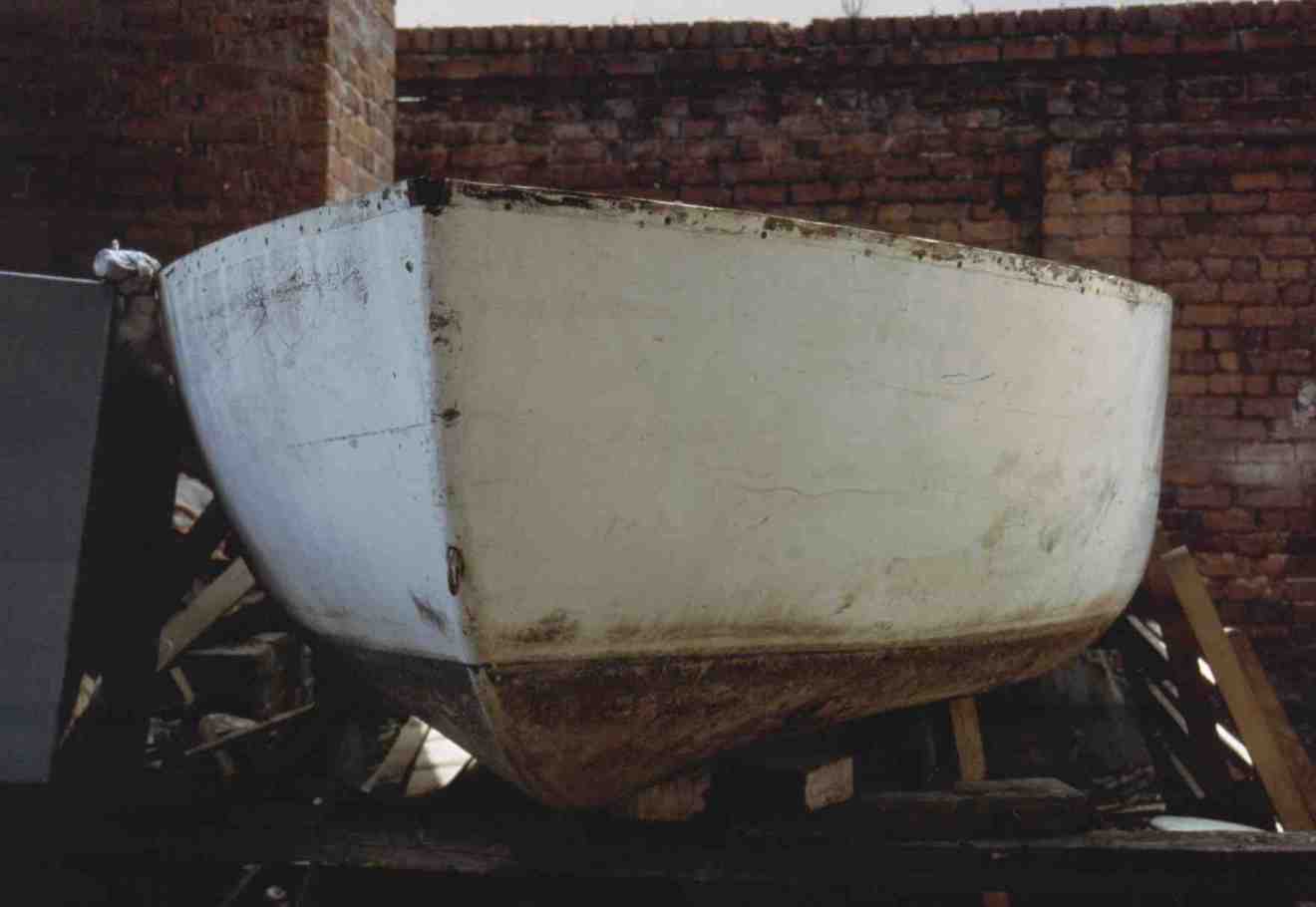
The old Marlin hull stripped of its superstructure stored at Taylors Boatyard in Chester in 1992
Whilst writing this chapter I have consulted my friends, children and my brother on many occasions when my memory has failed to provide information or details. When I thought that this chapter was finished, my brother… Jim suggested an alternative ending. He thought that it would be more in keeping with the memory and restoration of “Phial” and follows in the form of an “Epilogue”.
I often wonder about the ultimate fate of “Phial”. I have recently revisited the boatyard in Northwich that I delivered her to in 1994. Since then, the boatyard has changed hands and the new owners have no knowledge of her. Jim and I have visited various locations on the Weaver trying to track her down, when friends have been cruising on the River Weaver I have asked them to keep a look-out for her and when I have been on the river I have also looked for her... all to no avail. It would be nice to have sufficient funds to locate her and complete the task that I started at the beginning of this chapter. It would be even nicer to commission Taylor’s Boatyard in Chester to initiate a complete rebuild.
One of the failings of “Phial” was that her hull length was only eighteen feet six inches. It would have been much better had she been nearer thirty feet long. An extra ten feet in length added to the hull at the widest point would have given a more useful length and allowed more space for the various facilities on board. In 1967 Father approached Mister Jones... one of “Phial’s” original builders with sketches illustrating a possible stretch to the boat with an extra ten feet added, thus making “Phial” more like a Fairy “Swordfish” than a “Huntsman” or “Huntress”, complete with centre cockpit and inboard motor. Jim and Father would have preferred a Stuart Turner two-stroke petrol engine fitted but my choice today would have been for a BMC 1.5 diesel engine or something similar. But as it turned out, Marlin Craft had downsized their operations, were only building dinghies at this time and would not have had the resources to make “Phial” longer .

|
If "Phial" had been lengthened she may have looked |
|
something like this Charnwood centre cockpit cruiser |
Accordingly, the extension to “Phial” was originally just a pipedream and will remain so unless we are able to track her down and win the National Lottery in order to fund the project. This is always assuming that Taylors Boatyard could complete the task or a suitable boat builder could be found who would be willing to undertake such a project. We live in hopes though, and who knows, one day this pipedream might be fulfilled. The only problem then would be the name, at thirty feet long “Phial” would no longer qualify to be “A Small Glass Vessel”. Maybe we would have to rename her “Flagon” (a larger glass vessel).
Author’s Note...
This story is mostly written in chronological order. The preceding chapters were written before the happenings documented in “Canalscape 3, 4 & 5”. These happenings have impacted upon my conception of the ideal canal boat (which was previously a “Taylor”, “Highbridge Crusader” or a “Morgan Giles” (the former made from mahogany and the latter two made from glass fibre reinforced plastic). Subsequently, my opinions regarding steel narrowboats have since changed.
Chapter 5 - Is There Life Below Wigan?

"Is There Life Below Wigan?" is the title of an article I wrote that was published in "Waterways World" dated October 1991. The article documented the line of the Leeds and Liverpool Canal below Wigan. This area is very under-rated and a stroll along the towpath from Dean Locks, Gathurst (beneath the giant M6 viaduct), past Appley Bridge to Burscough is very rewarding.
Some time ago, I decided to produce an Audio/Visual Presentation on the “Mersey Ring” of waterways. This relatively unknown waterways ring encompasses most of the waterways in the Merseyside area and surrounding districts. The only canals left out are the “Shroppie” (the route takes us past its entrance locks at the Boat Museum, Ellesmere Port) and the St Helens Canal.
Starting at the southern portal of Preston Brook Tunnel, the Trent and Mersey Canal winds its way along the side of the River Weaver Valley (Vale Royal). At Anderton, the lift drops craft down to the Weaver, back down the valley to where it joins the Manchester Ship Canal at Weston Point. From here, the Ship Canal takes the route through Stanlow Oil Refinery, past the Boat Museum and on to Eastham, the start of the canal, and the location of the largest locks in the country, which allows access to the River Mersey Estuary.
The tidal and swift currents of the Mersey pass the world famous landmark of Liverpool’s Pier Head and on to the entrance locks of Stanley Dock where the Leeds and Liverpool Canal starts. The canal winds its way through the industrial part of Liverpool and then on to Wigan where the Leigh Branch is joined to give access to the Bridgewater Canal, through Manchester and eventually, back to Preston Brook Tunnel.
The old Wigan Power Station before demolition in 1986
Most of the photographs were taken from the boat, but some sections like the Manchester Ship Canal (which I have never cruised… yet) required footwork or on the Leeds and Liverpool up to Maghull, cycling. One section remained undocumented, this was the stretch from Maghull to Wigan Pier that I decided to cruise. A friend who had cruised this section told me that it was unremarkable and not a very rewarding stretch of canal. How wrong he was!
On leaving Wigan Pier, the canal, filled with duckweed, leaves the town behind, soon reaching the two locks at Pagefield and Ell Meadow. The locks originally had duplicated chambers but are now down to one. An urban wasteland soon gives way to a wooded section punctuated by the odd disused swing bridge and a lock chamber no longer in use due to subsidence. On rounding a corner, the village of Gathurst takes the boater by surprise with its pub, inviting moorings and well kept lawns.
Dean locks nestling beneath the M6 viaduct
Leaving the village behind, the River Douglas, which has kept the canal company for quite some time, can be glimpsed through the gaps in the trees, following the course of the canal almost exactly. After passing the Navigation Inn, the M6 Motorway viaduct looms in the distance. The motorway crosses not only the canal but also the River Douglas and a railway line, which crosses the canal diagonally beneath the viaduct.
The picturesque Dean Locks nestle in the valley overshadowed by the M6 Viaduct. Again, the locks have been duplicated, but this time, the second chamber has been retained. The lock keeper’s cottage is built of the beautiful stone that is a trademark of the canal, higher up in the Pennines. This well kept and landscaped area is in complete contrast to the previous locks and the smell of fresh paint and newly mown grass was mixing nicely on our visit.
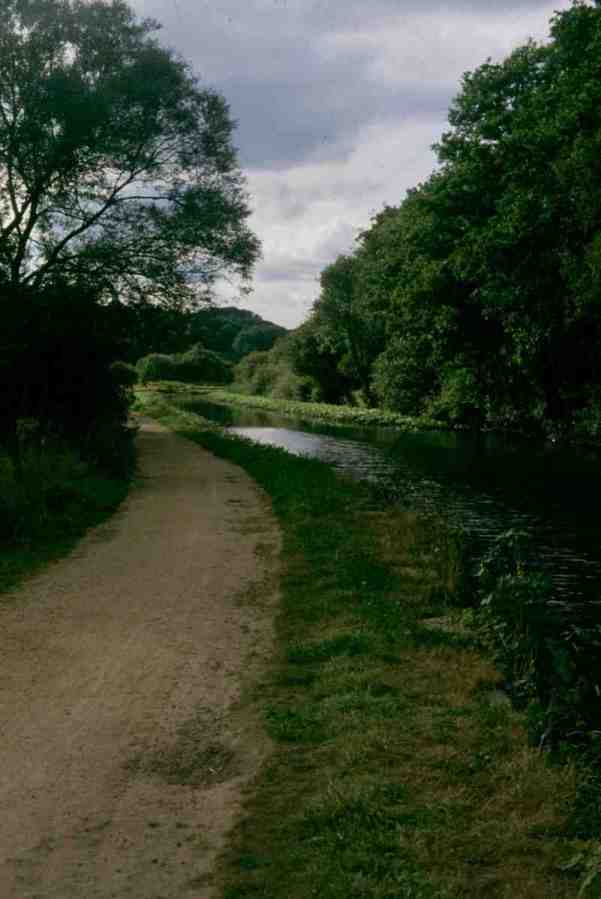
The River Douglas Valley between Dean Locks and Appley Bridge
For the next two miles, the canal winds through more of the wooded, picturesque River Douglas Valley. This area has an air of seclusion until the village of Appley Bridge is reached. After passing through a swing bridge, the moorings of the Douglas Valley Cruising Club are passed before the village is reached. The village centres on the canal, a pub and a linoleum factory. At one time there was a “fragrant” glue factory as well but this has now been demolished (I’m sure, much to the delight of local residents’ noses) and the site landscaped.
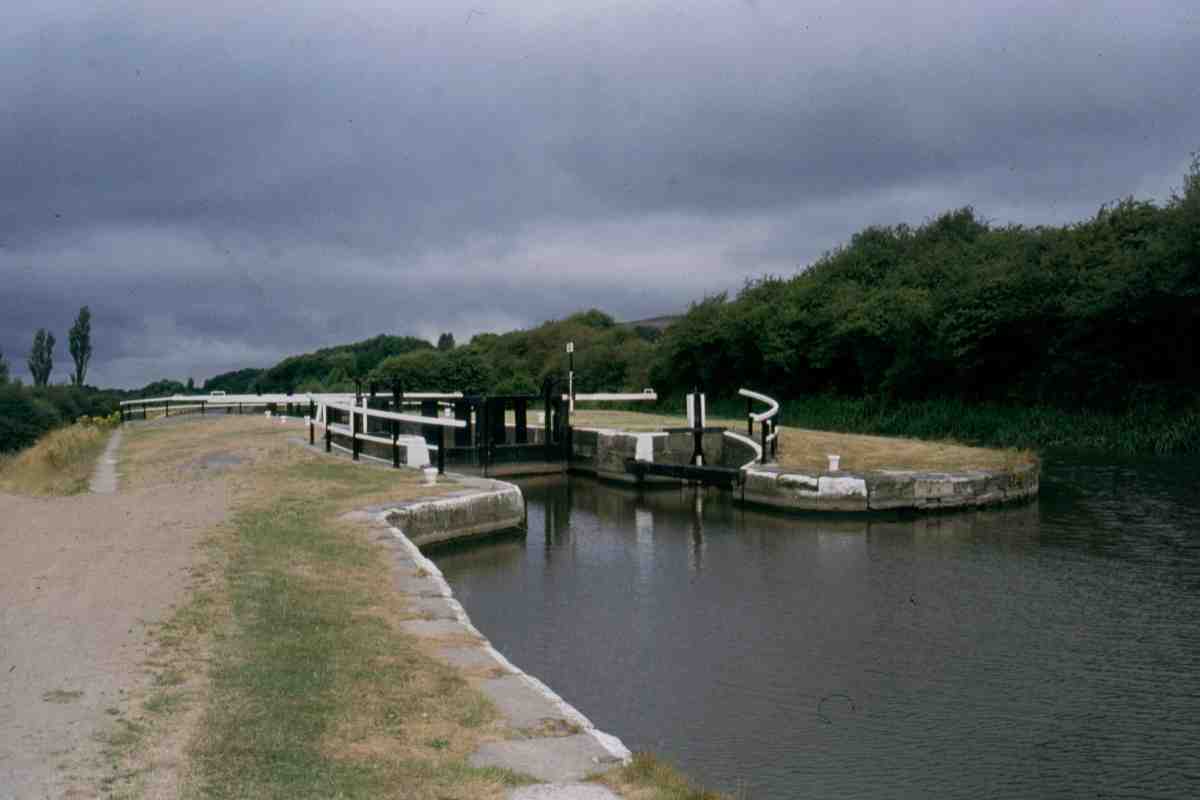
The lock with the twelve foot fall at Appley Bridge
The locks at Appley Bridge are again duplicated and lie in a most picturesque landscape. At the time of our visit, only one of the locks was in operation. This was the single lock and it is a real monster, having a fall of twelve feet. The duplicated section has two locks of six feet fall each and are not as daunting as their neighbour. Just after the single lock, the canal offers an unusual sight, with the lower level running alongside the upper level, separated only by the embankment that takes the canal to the smaller locks. After about half a mile, the two sections of the “dual carriageway” merge back into a single canal.
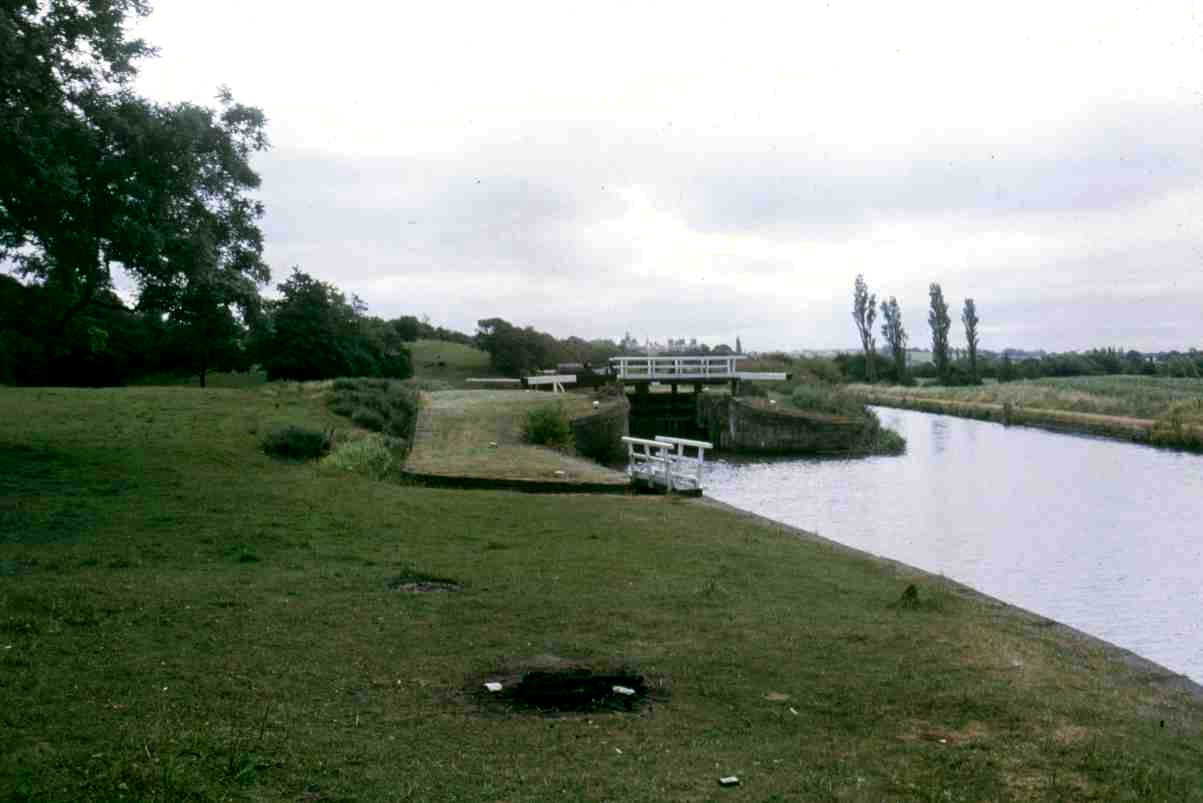
The junction of the upper and lower canal levels at Appley Bridge
After Appley Bridge, the canal continues along the wooded valley for another two miles to Parbold. Here, the old windmill looks out onto the changing face of the canal. At one time, the village overlooked rolling meadows, but now, a canalside housing development marrs the view. The village has shops and a supermarket to replenish provisions.
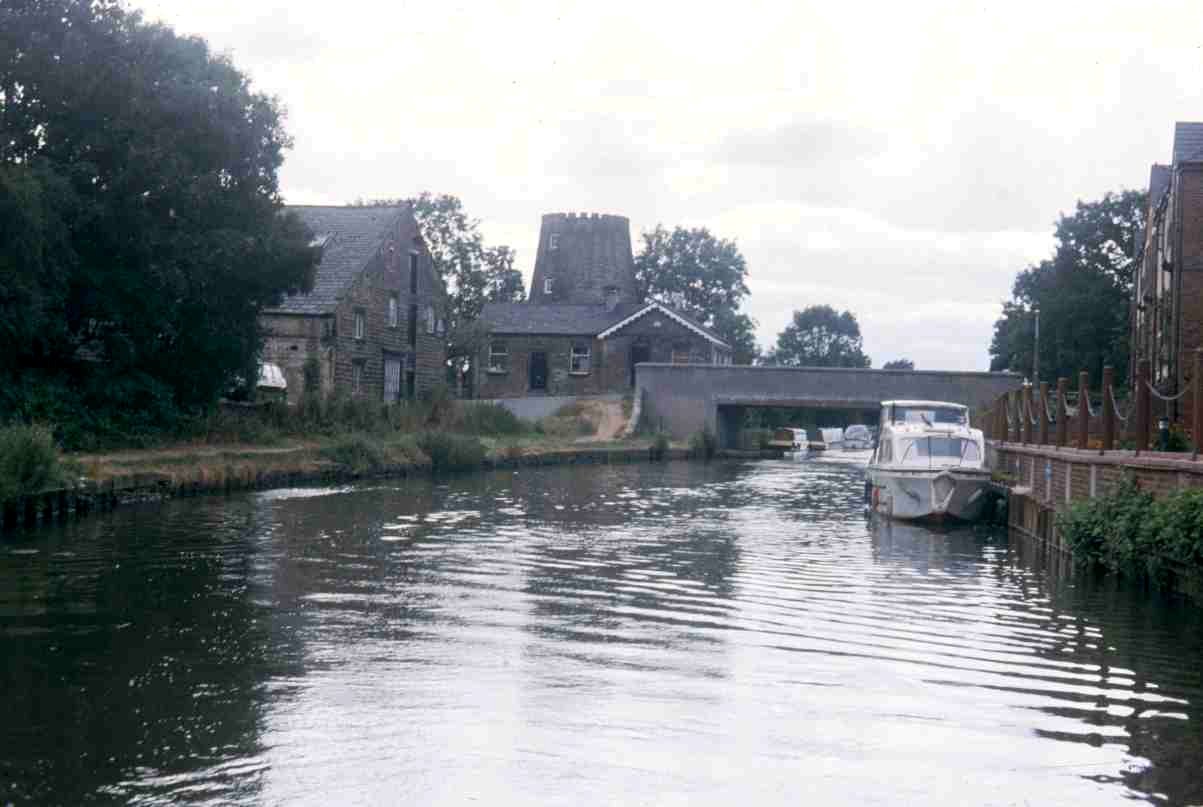
Parbold with the old sail-less windmill in the background
Immediately after leaving Parbold, the canal is carried across the River Douglas on a brick built aqueduct. As the Douglas is left behind, so is the valley through which the canal has flowed since leaving Wigan. In place of the valley, the canal winds across flat agricultural land until Burscough and the Rufford Branch is reached.
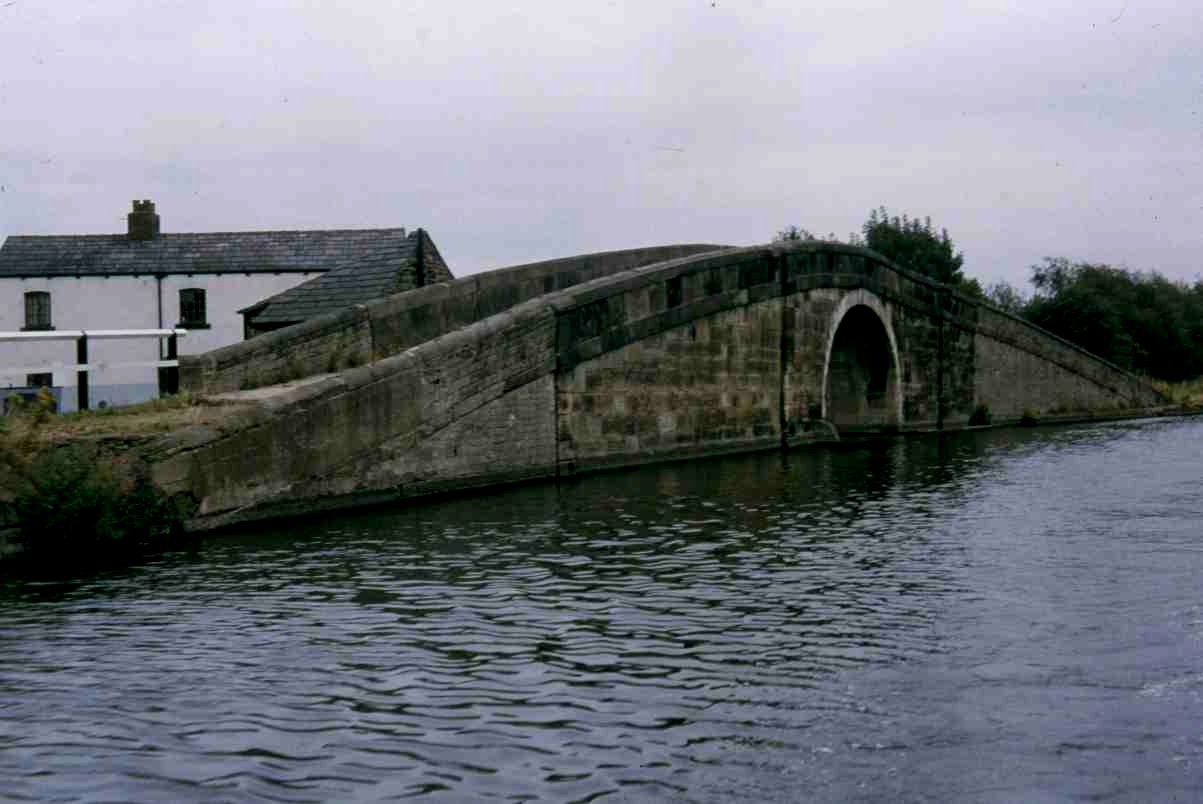
The sweeping Junction Bridge spanning the Rufford Branch entrance
Beneath a sweeping roving bridge can be seen the old dry dock that has been landscaped, the well kept lockside cottages and the locks that start the branch’s descent to the navigable part of the River Douglas and (eventually) the River Ribble. In the town of Burscough, there are all the usual amenities in addition to which, the BW yard has a water point and sanitary station.

The old dry-dock at the beginning of the Rufford Branch at Burscough
On leaving Burscough, the canal winds through more agricultural flatlands with the odd swing bridge (some of which are electrically operated) barring the way. The canal cuts through Scarisbrick Woods and, when it emerges, the buildings of the seaside town of Southport can be seen in the distance.
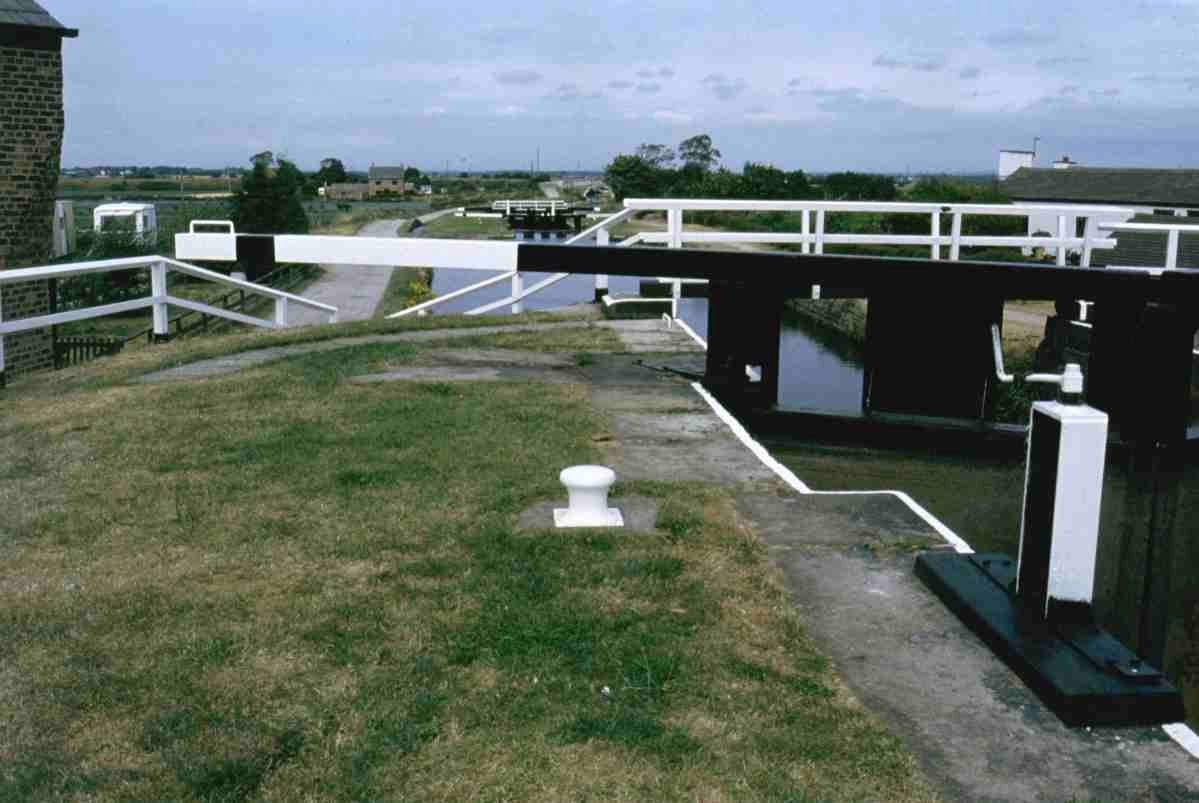
|
The Rufford Branch winding its way to The River Douglas, The River Ribble Estuary, |
|
The Millennium Ribble Link (Savick Brook) and ultimately... The Lancaster Canal |
The village of Halsall offers the “Saracen’s Head” public house with adjacent moorings and a children’s playground. The canal soon enters a rock cutting that has great historical significance as far as the canal is concerned. It was in this cutting, near to the 109 mile post that the first sod of earth was cut for the construction of the canal by a Charlie Mordaunt in November 1770. The canal continues to Lydiate and Maghull, where there is a shopping centre and railway station.
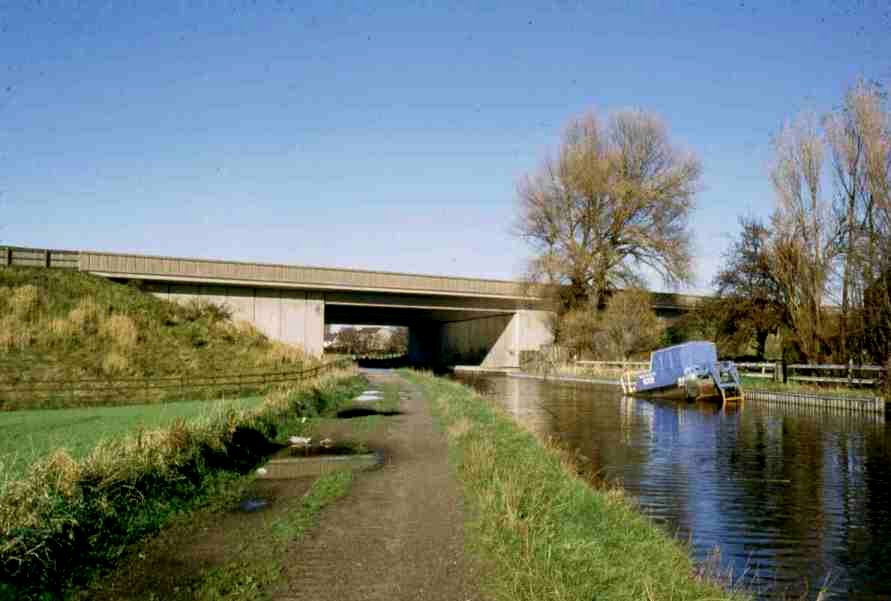
A recently reconstructed railway bridge over the canal at Maghull
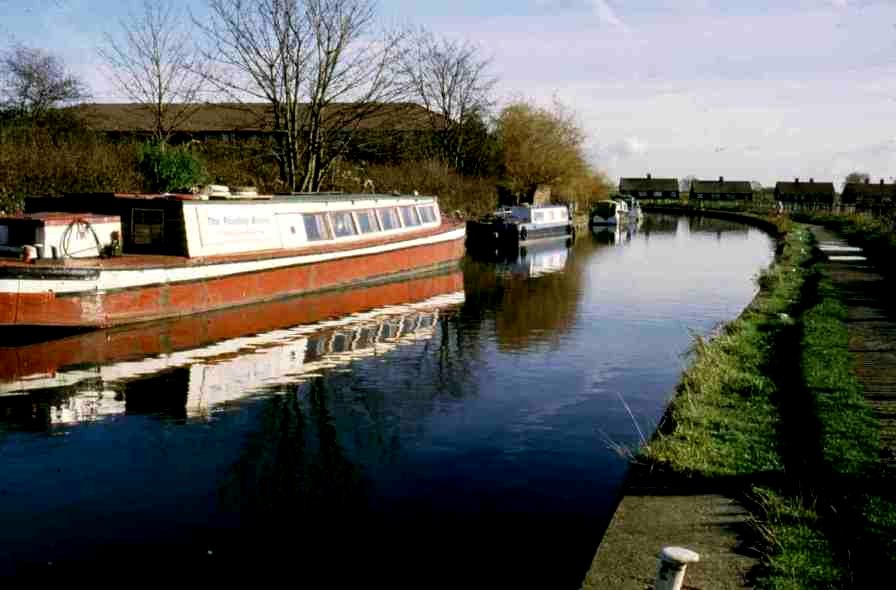
Boats moored at Lydiate on the outskirts of Liverpool
Between Maghull and Aintree is the last open countryside before the outskirts of Liverpool are reached. An embankment leads to the aqueduct over the River Alt. After the swing bridge at Aintree, the canal skirts the world famous race course with its notorious “Canal Turn”. There is a shopping centre at Aintree and is a convenient point to turn around if the journey through Bootle and Liverpool does not appeal. There is a regular train and bus service into the city centre.
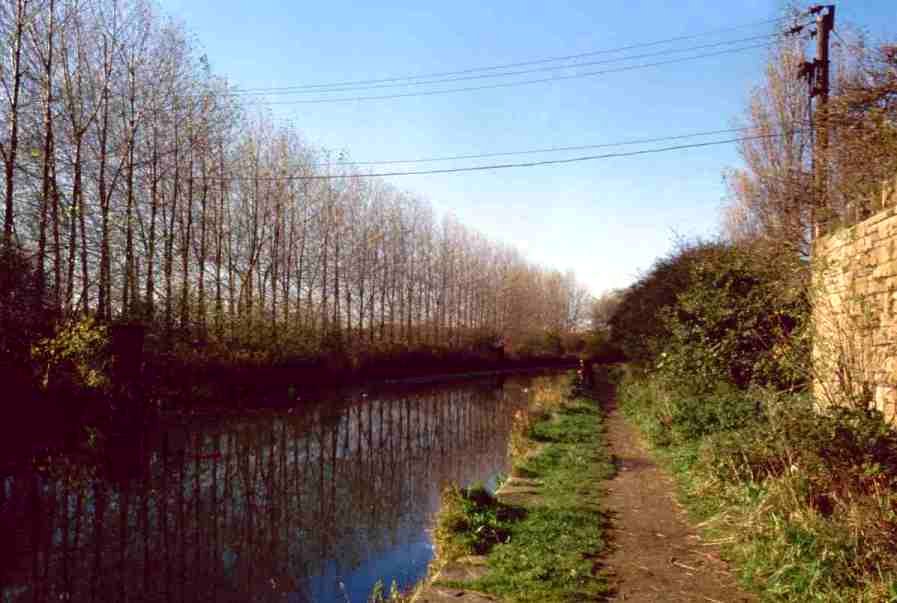
A quiet stretch of canal at Old Roan near Aintree
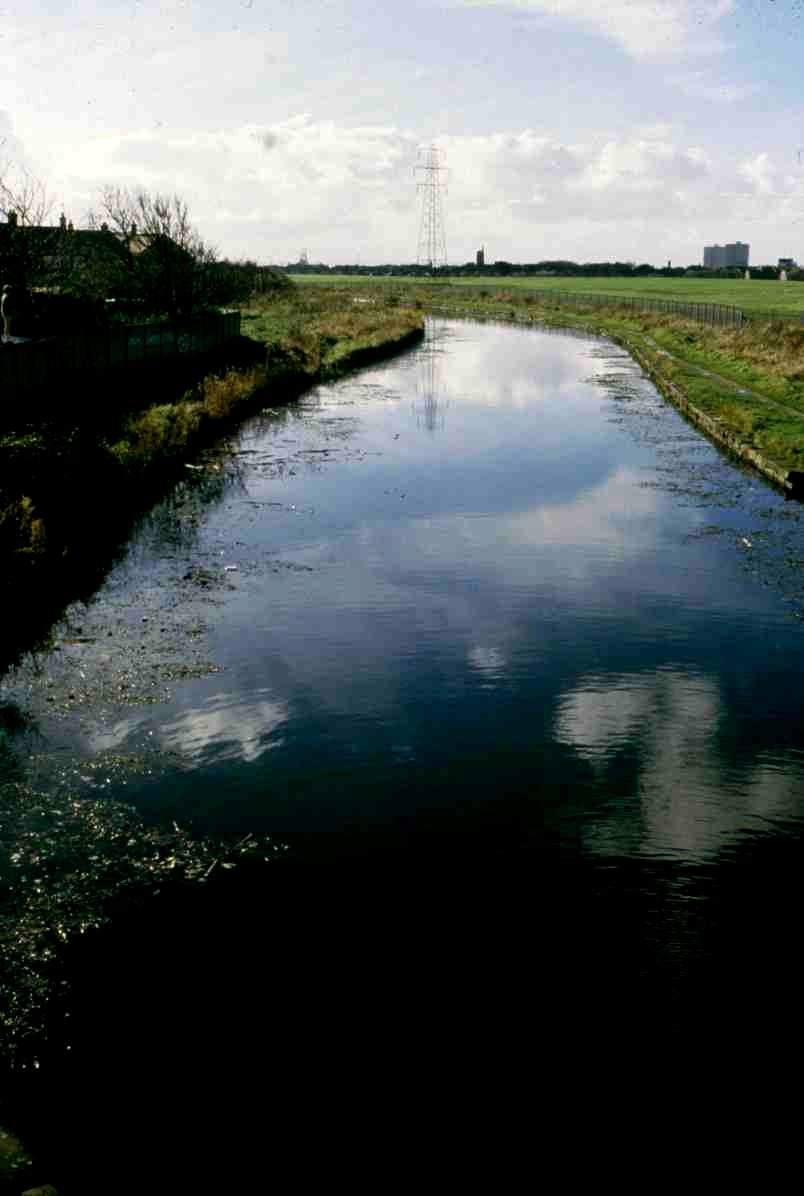
The world famous (or infamous) "Canal Turn" at Aintree racecourse
The adventurous wishing to continue along the canal to the Stanley Dock terminus must notify British Waterways Section Manager at Wigan (01942 44449) giving at least twenty-four hours notice. This is due to the necessity of having the high security locks on the swing bridges and locks (if descending into the dock system) to prevent vandalism through the city section. A member of BW’s staff will accompany boats wishing to navigate this section (staff availability allowing).
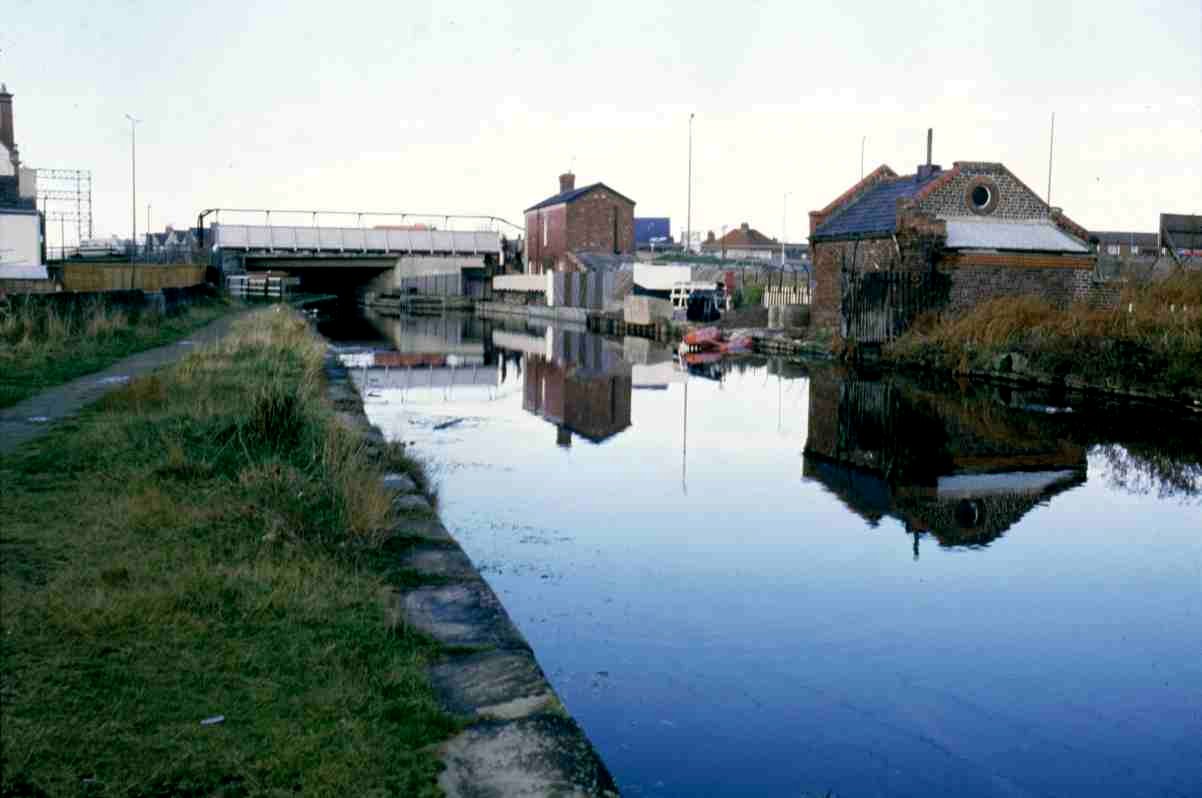
Litherland... approaching Liverpool's Docklands
The pylons that once straddled the canal near Sandhills, Liverpool
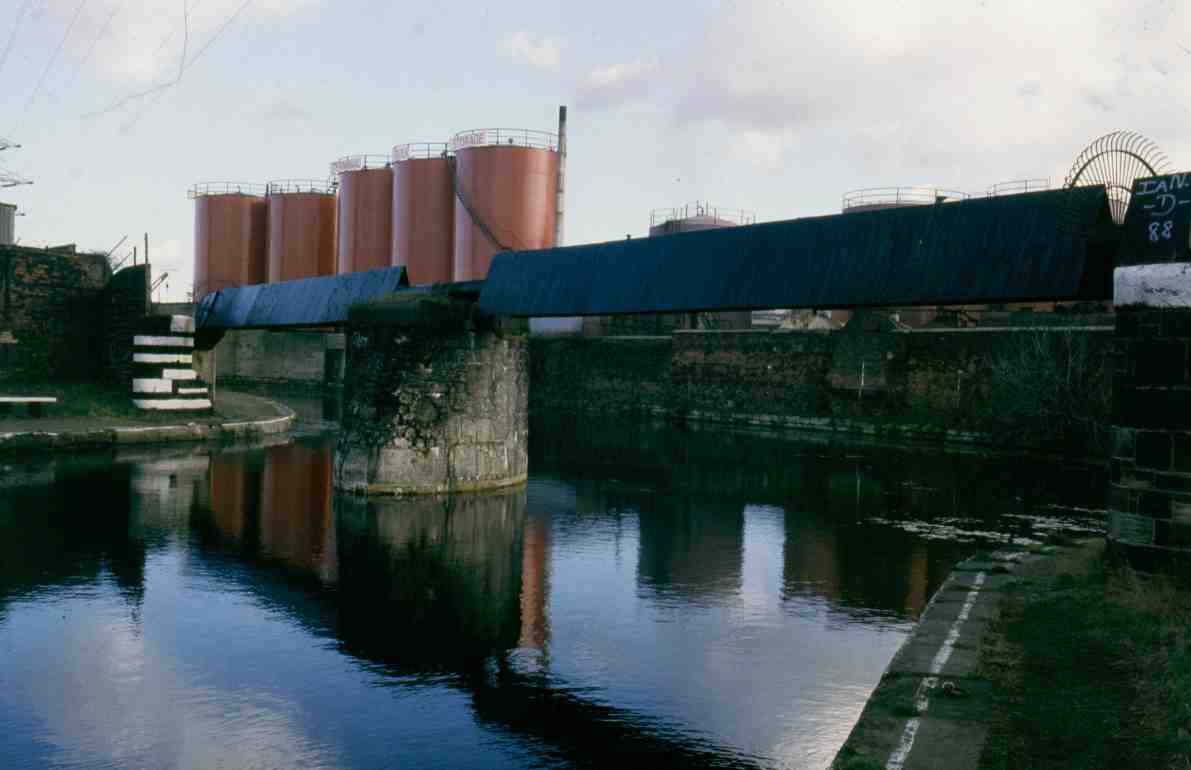
The start of the Stanley Dock Branch in Liverpool with Wigan to the left and Eldonian Village to the right
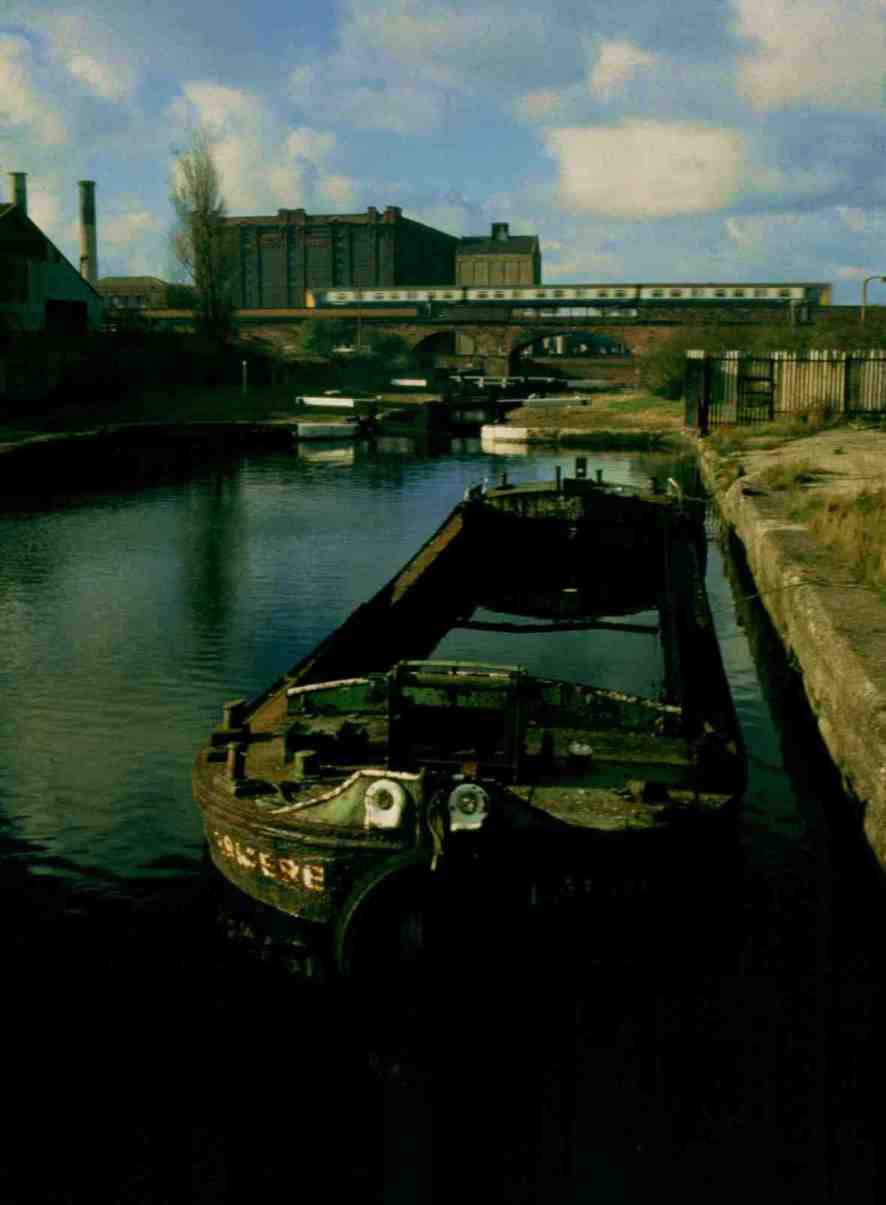
|
Looking down the locks on the Stanley Dock Branch towards |
|
Great Howard Street and the old Tobacco Warehouse |

|
The short tunnel that takes the canal beneath |
|
Great Howard Street before entering Stanley Dock |

|
Stanley Dock... The canal enters beneath the bridge in the centre |
|
of the photograph and the old Tobacco Warehouse is on the right |
Everyone (except for my aforementioned friend) that has cruised this part of the Leeds and Liverpool Canal agrees that, in places, it is an extremely pretty section. It deserves to be used more that it is and I hope that this article will encourage others to prove that there is life below Wigan!
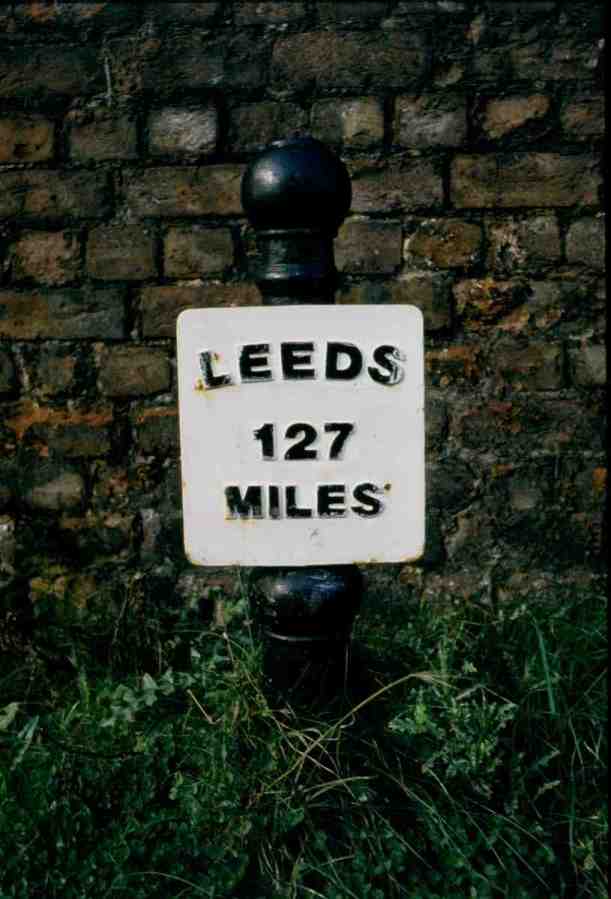
The milepost near the end (or is it the beginning) of the canal at Liverpool
The continuing story of this length of the Leeds and Liverpool Canal as well as The Liverpool Docks Link... the new canal constructed to connect the Leeds and Liverpool Canal to Liverpool’s Albert Dock and South Dock System is documented in "Canalscape Book 4", Chapter 5 which is entitled Is There Still Life Below Wigan?
|
|
|
|
A list of major milestones in my canal cruising experiences from 1983 to 1999 |
|
|
|
|
| September 1983 | Bought “Misty Waters 1” |
| July 1984 | Llangollen & Shropshire Union Canals to Llangollen (Misty Waters I) |
| October 1985 |
Moved moorings from Beeston to Preston Brook Marina |
| March 1986 |
Commenced writing “The Bridgewater Book” (later renamed “The Duke’s Cut”) |
| July 1986 |
Leeds & Liverpool Canal to Skipton (Misty Waters II) |
| July 1987 |
Cheshire Ring and excursion to Ellesmere Port (Misty Waters II) |
| August 1988 |
IWA Rally at Castlefield... Manchester |
| August 1988 | Leeds & Liverpool Canal towards Scarisbrick (Misty Waters II) |
| July 1989 |
Trent & Mersey and Shropshire Union Canals to Ellesmere Port and Audlem (Misty Waters II) |
| January 1990 |
“Misty Waters II” sold |
| October 1991 | "Is There Life Below Wigan" published in "Waterways World" |
| September 1992 |
Bought “Phial” , brought her to Wallasey, placed her in back garden and commenced restoration |
| October 1992 |
“Is there Life Below Wigan Pier” published in “Waterways World” |
| March 1994 |
Bridgewater and Trent & Mersey Canals to Broken Cross (Painted Lady) |
| June 1994 |
“Phial” sold partly restored and delivered to the River Weaver at Northwich |
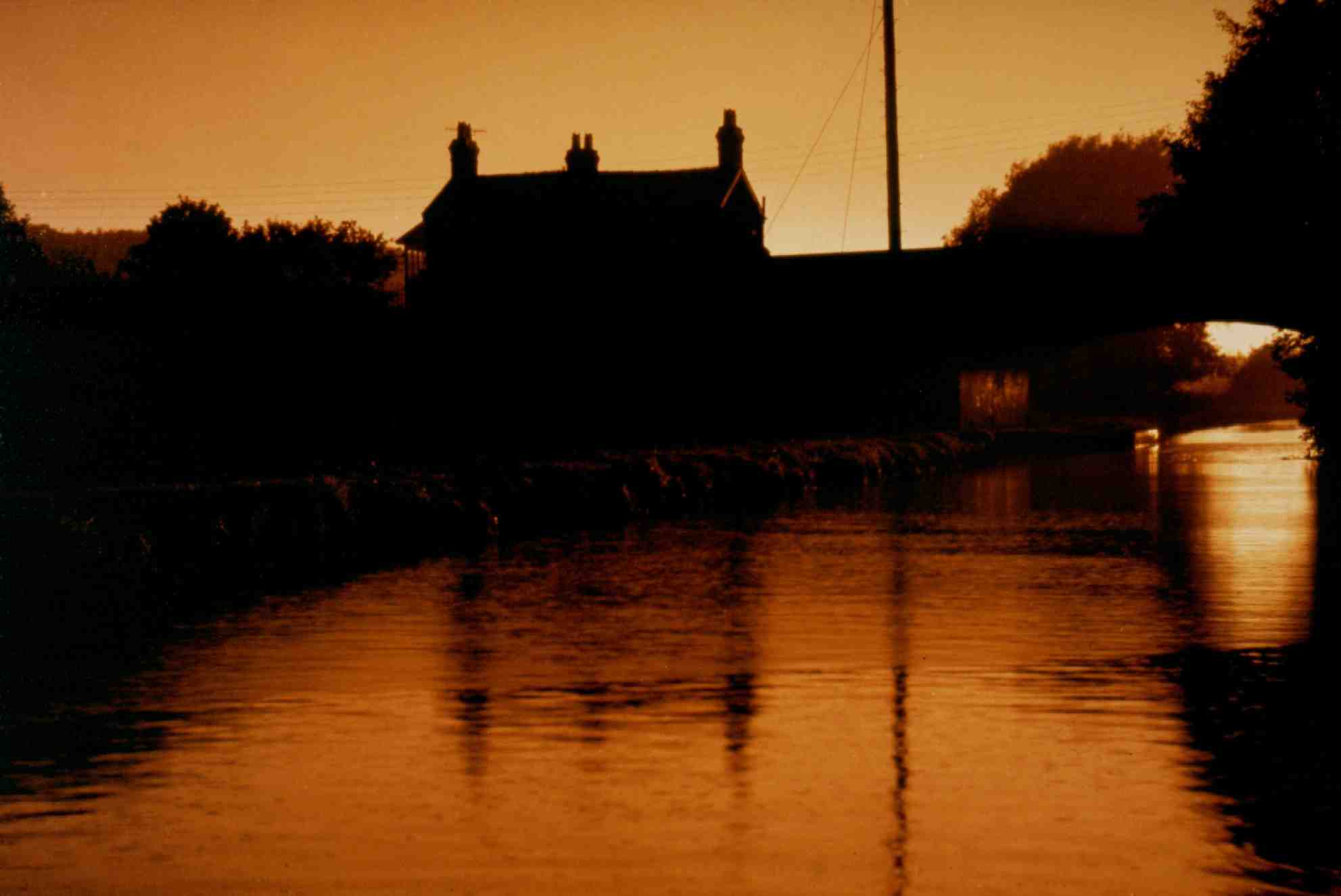
Sunset, Bridge 107 at Beeston on the "Shroppie"
 |
|
Book 3 |
Canal Cruising 2000 to 2005
or select another book below...
|
Contents Click here for the latest entries or on the required section in the Contents below to follow links
|
|
|
|
Book 7 - 2011 |
|
|
Book 10 - 2014 |
|
The Wonders of the Waterways |
|
| NB Squirrel | |
| Canis Canalus | |
| Shannon | |
| Canalscape Photography | |
| Lymm Cruising Club Website | |
| Site Map | |
| Go to the | |
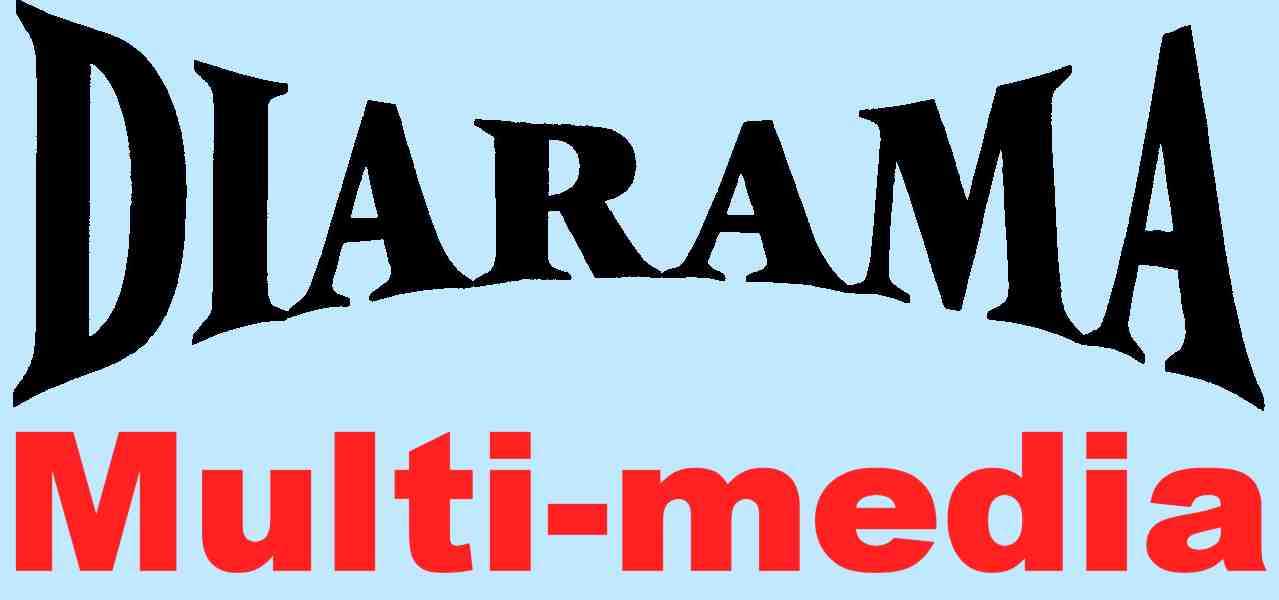 |
|
| Website | |
|
|
|
"Canalscape" and "Diarama" names and logo are copyright |
Updated 03-12-2013